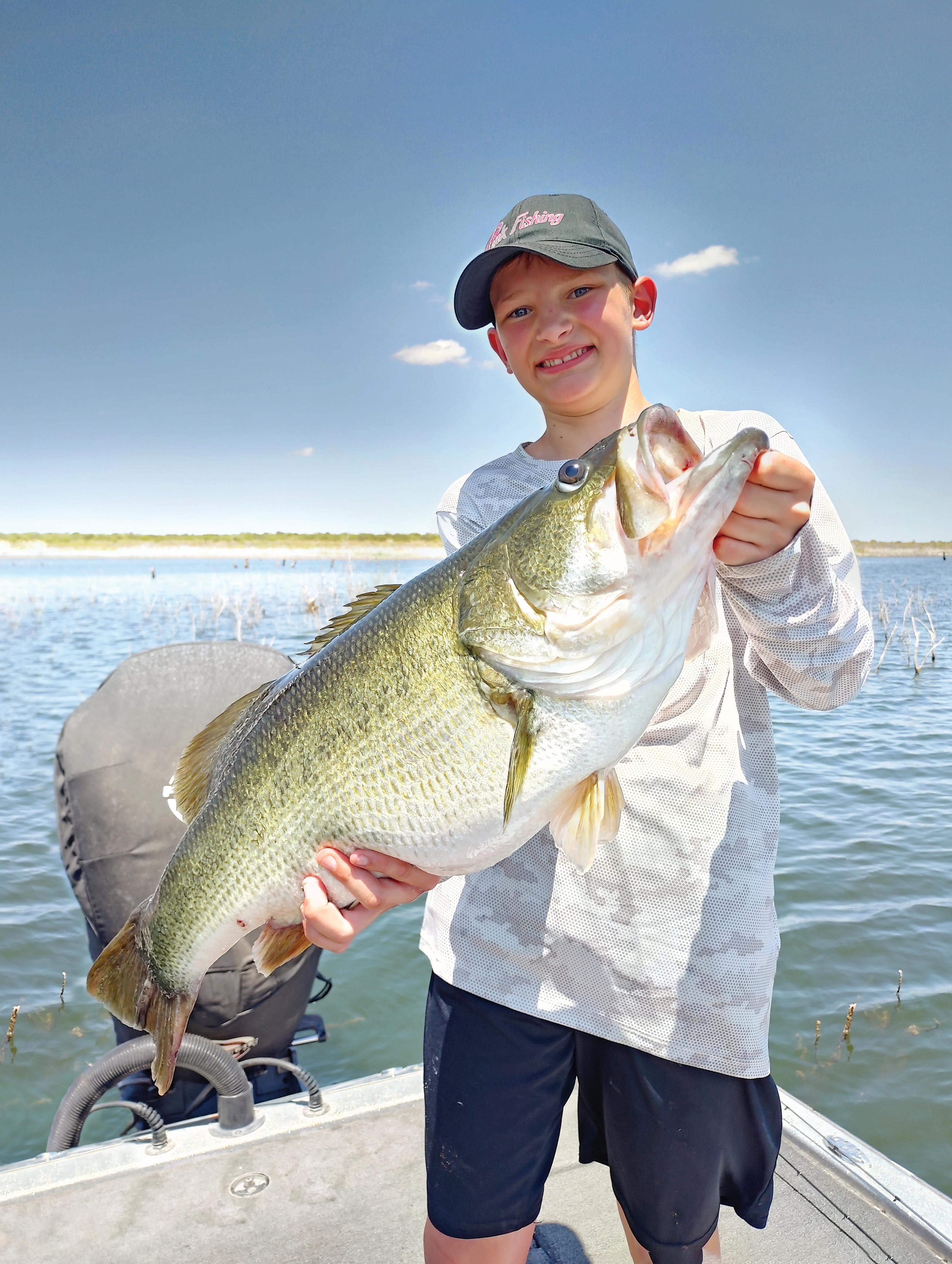
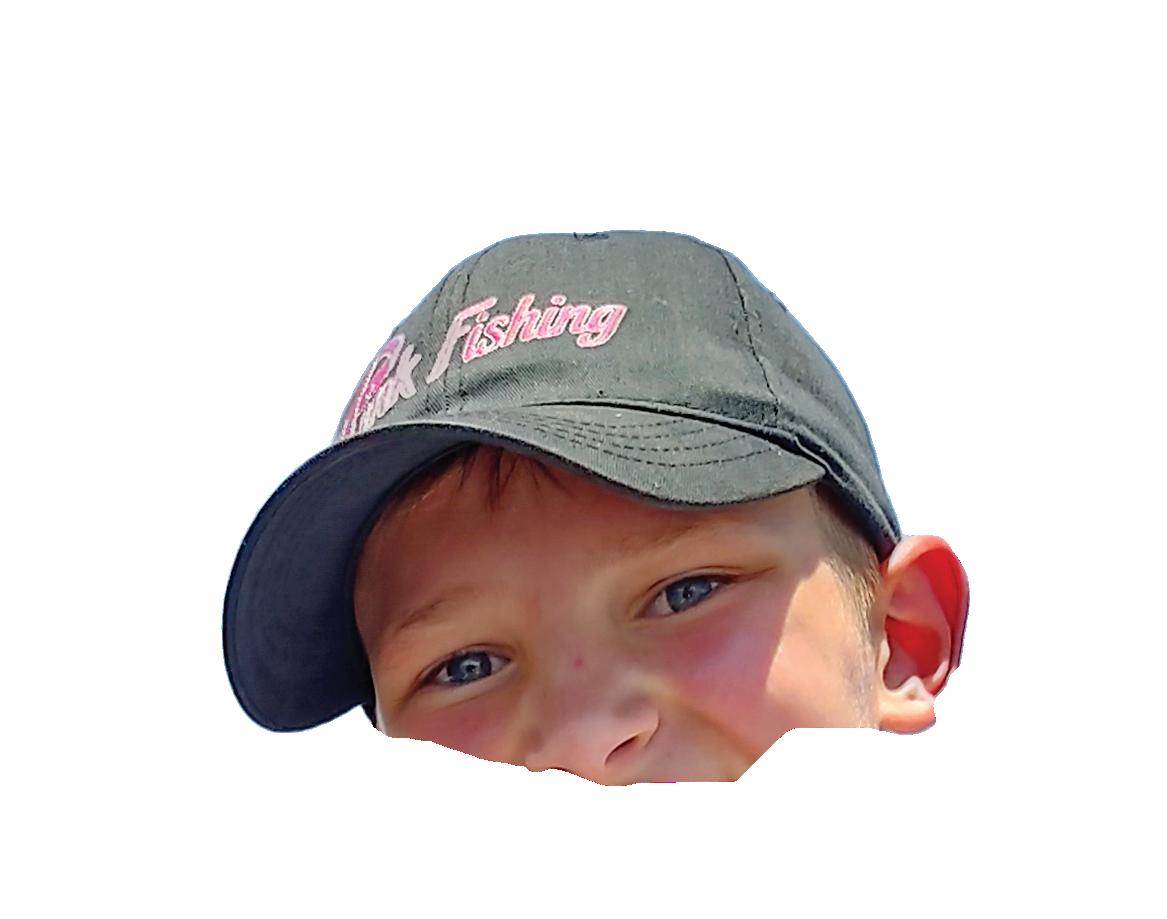




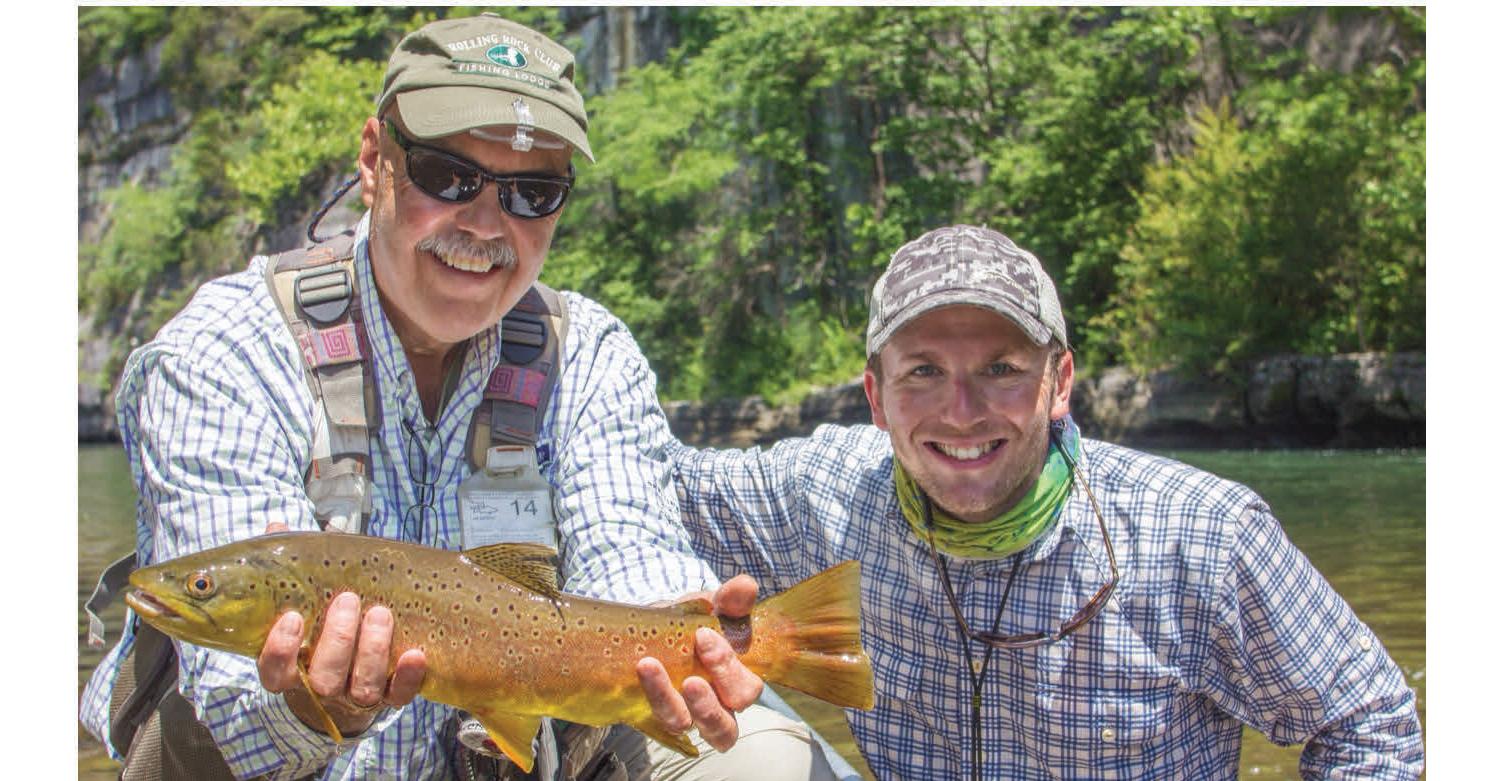
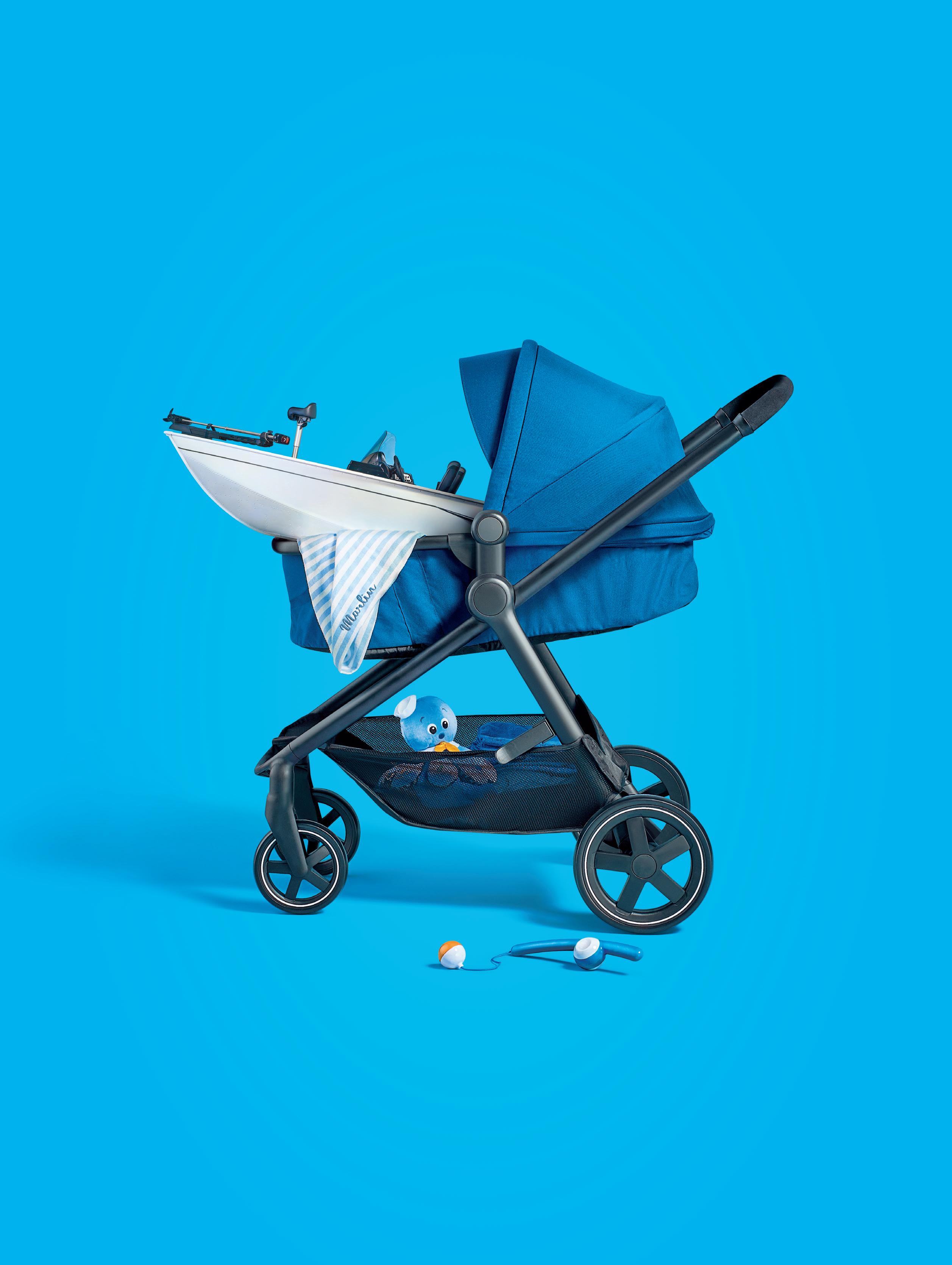











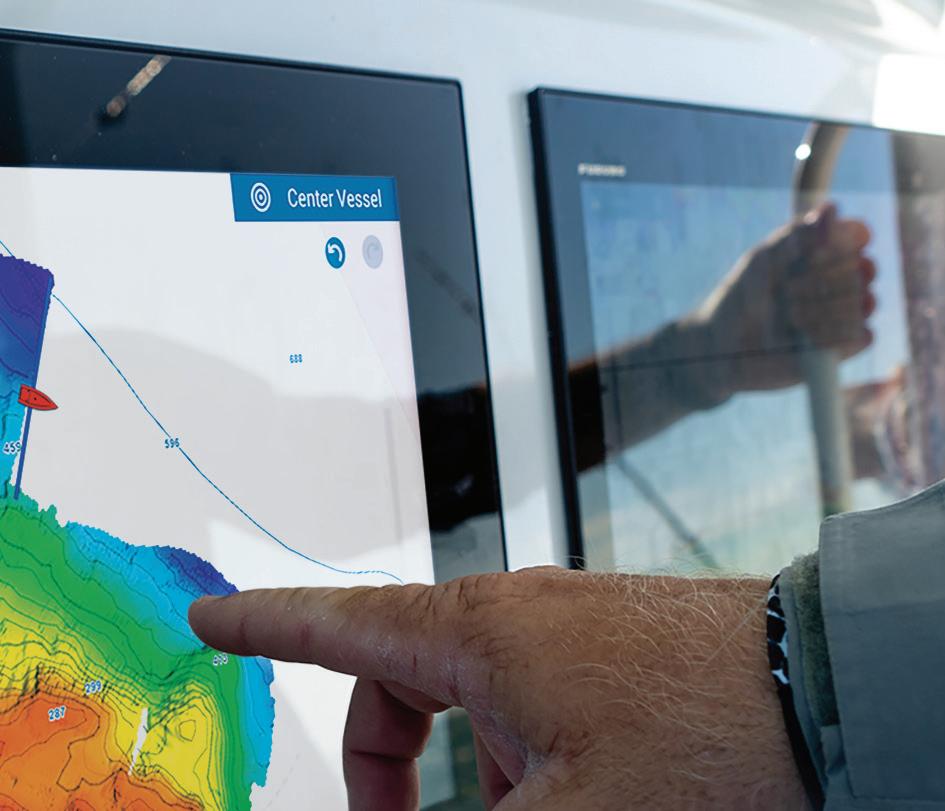






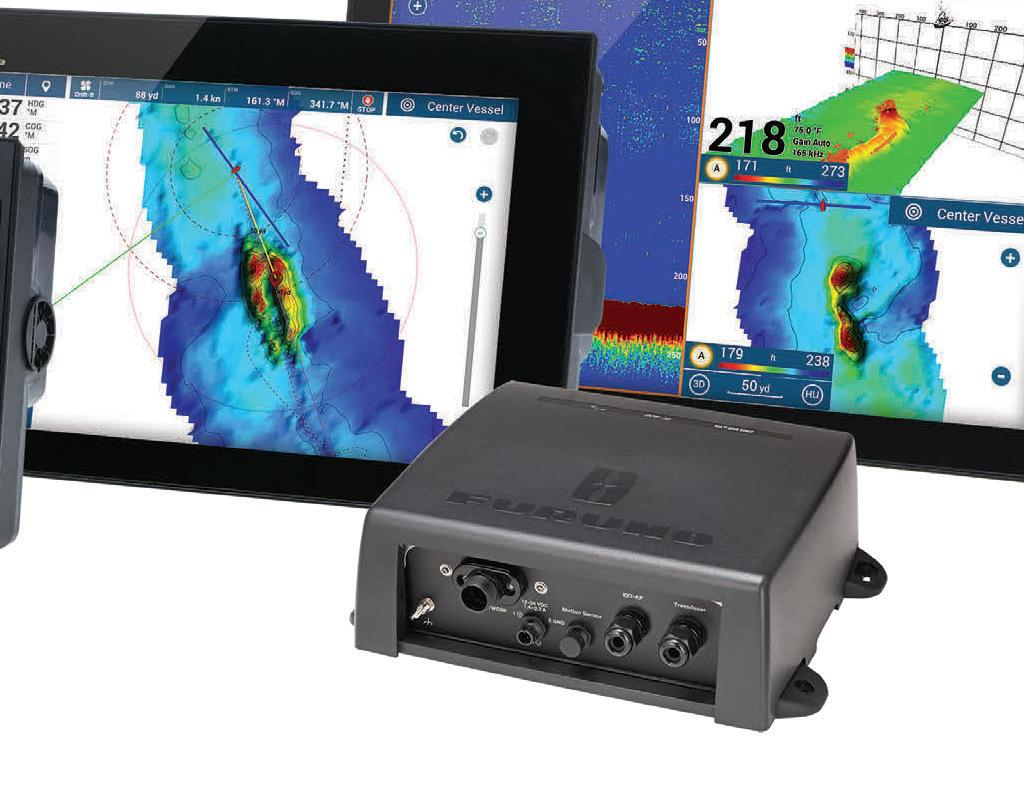






































We’re going to let you in on a secret. Billionaires have billions because they know value is not increased by an in ated price. ey avoid big name markups, and aren’t swayed by ashy advertising. When you look on their wrist you’ll nd a classic timepiece, not a cry for attention–– because they know true value comes from keeping more money in their pocket. We agree with this thinking wholeheartedly. And, so do our two-and-a-half million clients. It’s time you got in on the secret too. e Jet-Setter Chronograph can go up against the best chronographs in the market, deliver more accuracy and style than the “luxury” brands, and all for far, far less. $1,150 is what the Jet-Setter Chronograph would cost you with nothing more than a di erent name on the face.


With over two million timepieces sold (and counting), we know a thing or two about creating watches people love. e Jet-Setter Chronograph gives you what you need to master time and keeps the super uous stu out of the equation. A classic in the looks department and a stainless steel power tool of construction, this is all the watch you need. And, then some. Your satisfaction is 100% guaranteed. Experience the Jet-Setter Chronograph for 30 days. If you’re not convinced you got excellence for less, send it back for a refund of the item price. Time is running out. Now that the secret’s out, we can’t guarantee this $29 chronograph will stick around long. Don’t overpay to be underwhelmed. Put a precision chronograph on your wrist for just $29 and laugh all the way to the bank. Call today!




 By Nick Carter
By Nick Carter
Winter is the best time to sh,” said Capt. Chris Cameron, “the only problem is the weather.”
Capt. Cameron is owner/operator of Fired Up Fishing Charters out of Cocoa Beach, Fla. He said it was tough to nd good weather windows this November and early December, but that o shore shing is primed to re o like a Space Coast rocket whenever conditions stabilize.
Winter on Florida’s Atlantic Coast can be spectacular because of all the migratory species that push down to overwinter in milder temperatures. King sh, cobia, black n tuna, sail sh and others are all hunting the reefs about 18 miles o Port Canaveral. e key to the shery is menhaden.
“ is time of year, you get these huge baitballs,” said Capt. Cameron, “and there are all these sh following the bait around. You nd sh where you nd ‘bunka’ congregating on the reefs.”
Cameron is a transplant from Long Island, New York, and even a er more than two decades living and shing Florida’s east coast, he still refers to menhaden as “bunka,” which is Yankee dialect for bunker, which is what they call pogies up where boats are winterized this time of year.
“On good days, when you can get o shore and the water is clean, we might catch a limit of kings, a couple cobia, a couple black ns and hopefully a sail sh,” Cameron said. Even with 2022’s tightening of cobia regs, that’s a fun and delicious mixed bag to ll the freezer.

At places like Pelican Reef and 8A Reef, where depths range from 75 to 85 feet, Cameron nds the bait and then goes to work slow trolling live baits on double-hook stinger rigs and 20-pound line and tackle. He said he pulls baits at about 1 knot, which allows them to swim along naturally.


“ e thing with slow trolling is you never know what you’re going to get,” said Cameron. “It could be a big king, a sail sh, a cobia or a shark.”
Pitch rods are kept ready in case a cobia shows up on the surface. Cameron said he’s learned from experience not to over-stimulate cruising cobia by throwing multiple lines at once. Usually, clients can convince cobia to bite with a one-two punch. ey keep a squid-tipped bucktail ready for a quick cast. If that doesn’t draw a strike, it allows time to slap a live bait on the second rig, which is a simple 5/0 circle hook.
Shrimp boats are another option Cameron seeks out this time of year. Although chasing them can be a bit of a time gamble, since they are usually 25 miles o shore over 200 feet of water, they can be extremely productive.
“If you see a shrimp boat o in the distance or spot one on the radar, it’s almost always worth a shot,” Cameron said. “When they dump their bycatch in the morning, it pulls everything up.”
Fishing shrimp boats can be short-lived, but
it can also provide fast action for the same species that come o the reef. For this bite, Cameron beefs up to 6500 spinning gear and 50-pound braid and 50-pound mono leaders. He keeps four pitch rods ready, two with bucktails and two with live baits, because the bite can turn into sight shing

in a hurry. Meanwhile, he’ll search with freelined pogies on a knocker rig.
Contact Capt. Chris Cameron and Fired Up Fishing Charters through their website at redupcharters.com.

Winter’s cold fronts consolidate wahoo to their preferred temperature ranges across their range. is makes them easier to target than at any other time of year. e following is a short list of very good destinations for wintertime wahoo.


San Salvador, Bahamas: Way out in the Atlantic in the southern Bahamas, the waters o San Salvador hold one of the best wahoo sheries in the world. Peak wahoo season is December through April, when hordes of ’hoos migrate to the area’s warm waters. e island might just be the

best place on the planet for a shot at a triple-digit wahoo, and the right conditions can yield fast action for 50-pounders, as well.

Within a short 10-mile run o the island, a seamount rises to 180 feet from 4,000 feet of water. is hump is a well-known feature, where wahoo congregate to feed on schools of small tuna. e remoteness of San Salvador keeps shing pressure in check, but it also makes this one of those bucketlist trips you plan ahead for.
Galveston, Texas: O shore humps out of Galveston, Texas also lay claim to some of the best wahoo shing in the world, and every winter anglers connect with giants. is shery, however, is reserved for anglers with the gumption to make 100-mile overnight runs to features like East and West Flower Gardens to catch the morning bite.
Windows of good weather and big, fast boats are a requirement to reach the shing grounds at the edge of the Continental shelf, where wahoo pile up with bait sh on steep depth changes of rock structure.
Murrell’s Inlet, South Carolina: O the South Carolina coast, cooling water temperatures con ne wahoo to the warm water at the edge of the Gulf Stream. is makes them much easier to target than when they are spread out in summer.
Depth changes and structure at the edge of the Continental Shelf, combined with warm 70 to 80 degree waters of the Gulf Stream can be found 50 or 60 miles o the coast. ese structures hold bait sh in the temperature range where wahoo are comfortable. Covering lots of water with high-speed spreads trolls up the best wahoo of the year, every year.
Venice, Lousiana: It seems everything o shore of Louisiana is about the oil rigs, and in wintertime the oil rigs are all about wahoo. e key to nding wahoo on the rigs is nding the right temperature range, and the magic number is 60 degrees. Wahoo congregate and feed around the rigs where there is bait and water temperatures of at least 60 degrees.
One of the great things about Venice is there are deep-water rigs relatively close to shore at just 15 or 20 miles, which means it’s possible to nd a good weather window and go. e Louisiana coast also boasts some of the best catch rates for wahoo in the world, and 50- to 60-pound sh are the norm.
The very best hunting knives possess a perfect balance of form and function. They’re carefully constructed from fine materials, but also have that little something extra to connect the owner with nature.


If you’re on the hunt for a knife that combines impeccable craftsmanship with a sense of wonder, the $79 Huntsman Blade is the trophy you’re looking for.
The blade is full tang, meaning it doesn’t stop at the handle but extends to the length of the grip for the ultimate in strength. The blade is made from 420 surgical steel, famed for its sharpness and its resistance to corrosion.


The handle is made from genuine natural bone, and features decorative wood spacers and a hand-carved motif of two overlapping feathers— a reminder for you to respect and connect with the natural world.
This fusion of substance and style can garner a high price tag out in the marketplace. In fact, we found full tang, stainless steel blades with bone handles in excess of $2,000. Well, that won’t cut it around here. We have mastered the hunt for the best deal, and in turn pass the spoils on to our customers.
But we don’t stop there. While supplies last, we’ll include a pair of $99 8x21 power compact binoculars and a genuine leather sheath FREE when you purchase the Huntsman Blade.

Your satisfaction is 100% guaranteed. Feel the knife in your hands, wear it on your hip, inspect the impeccable craftsmanship. If you don’t feel like we cut you a fair deal, send it back within 30 days for a complete refund of the item price.

Limited Reserves. A deal like this won’t last long. We have only 1120 Huntsman Blades for this ad only. Don’t let this beauty slip through your fingers. Call today!
“This knife is beautiful!” — J., La Crescent, MN
“The feel of this knife is unbelievable...this is an incredibly fine instrument.” — H., Arvada, CO

With grouper season over, it’s time to switch gears and concentrate on other species. is is the time of year to size down and go for the snappers. Depending on water temps, it’s also a good idea to keep a light line out for any pelagics that swim by.


I love yellowtail and a mangrove snappers, but I really like jolt heads, trigger sh, pinkies, black seabass and hog snapper. I treat bottom shing like I’m going (organic) grocery shopping. First and foremost, I don’t shop on every aisle of the grocery store. I go down the aisles that contain the items I really want. e best groceries come from di erent places on the bottom and from di erent depths.
Farther north up the Atlantic coast there are a lot of beeliners (vermilion snapper) taking the place of yellowtails. In this mix will be trigger sh, which I absolutely love! Beeliners and trigger sh have one thing in common: the largest ones of the school stay higher in the water column. is is why I like to sh a level-wind reel versus a spinning reel with small circle hooks for this style of snapper shing. I start dropping one “strip” of the reel
at a time until I get down to the sh. A “strip” is the distance of raising the rod up with your thumb o the spool, and putting your thumb back on the spool. Simply let your thumb o the spool and let it fall in 10-foot “strips” while raising the rod tip upwards. Count the strips it takes to get down to the bites. Four strips will be approximately 40 feet deep. Note where you feel the rst bite. is will usually be the largest triggers and beeliners in the school. If you stop getting bites or you’re only catching smaller sh, let this same tackle go deeper or all the way to the bottom. is is where you’ll catch the jolt heads, black sea bass, mangroves and hogs.
I use a two-hook “chicken rig” made of 50-pound uoro with small circle hooks and a 3-ounce bank sinker. I bait it with small pieces of squid. A small 2- or 3-ounce jig works with the same tackle as the weight instead of a bank sinker. is is especially e ective on large triggers. Just replace the treble hooks or single


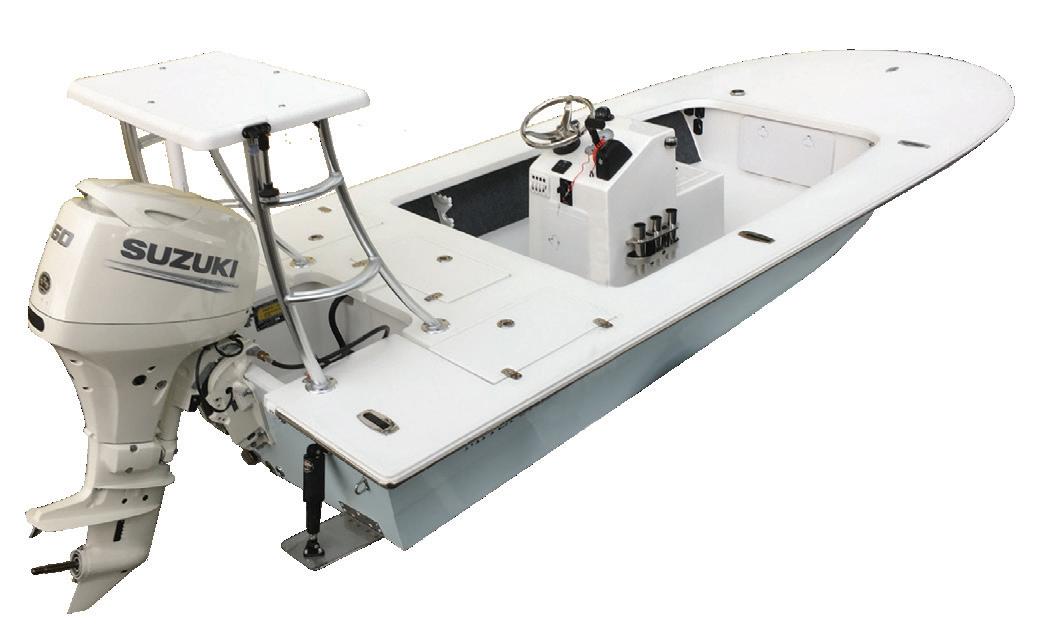




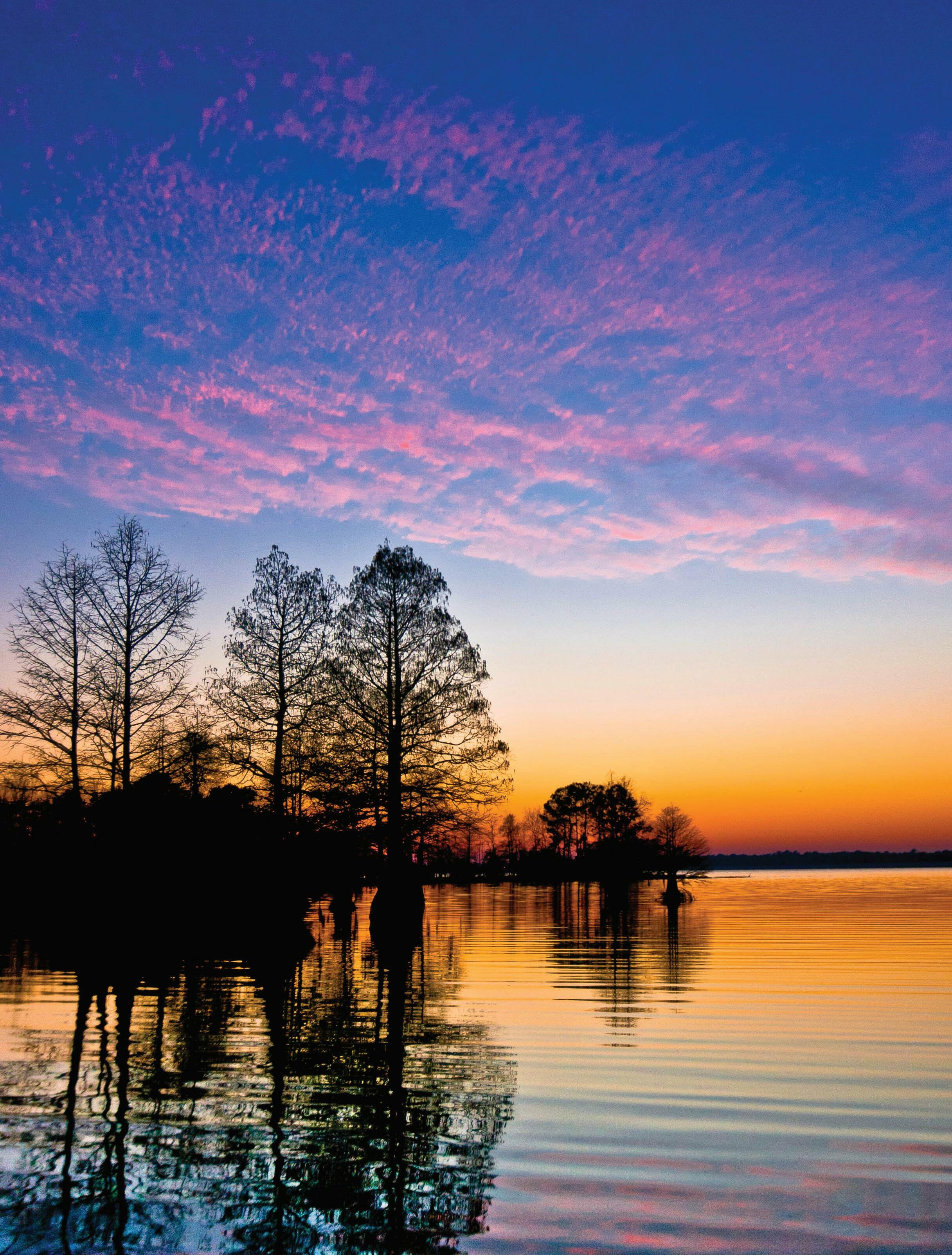
J hooks on the back of the jig with small circle hooks and tip with a small piece of squid.
I could go on and on about this style of shing. e limits are pretty good and the reward comes at the table. It is a good time of year to take youngsters out, because this style of shing produces lots of action, and it’s not heavy-duty grouper shing. Little ones love a trip to the “organic grocery store.”
See more from Tim Barefoot at www.barefootcatsandtackle.com and check out a video explaining this style of shing at https://bit.ly/3YcVzV1.


The gateway to the Tellico River, Bald River Falls, countless mountain trails and over 300 miles of wild and native trout streams.
Tellico River – The namesake of the town of Tellico Plains and Tellico Outfitters, and for good reason. The largest freestone trout stream in Tennessee, the Tellico River is a mix of wild and stocked rainbow and brown trout. There are even native brook trout in its headwater streams just across the North Carolina border, for those adventurous enough to find them. With weekly stockings of catchable and trophy sized trout throughout the spring and summer and 5 fall and winter months of Delayed Harvest with catch and release only regulations when some of the biggest trout of the year are planted in its waters, the Tellico has something for everyone. Whether you’re after a limit of trout to pan fry over a campfire during a summer family camping trip, gorgeous wild rainbows that shine like jewels, or the challenge of elusive wild browns that haunt deep pools but don’t come easy, the Tellico has it.
Bald River – If there is a crown jewel of the Tellico River system, it is the Bald River. Many visitors are familiar with beautiful Bald River Falls, which tumbles 90 feet from the streambed above to meet the Tellico River below. What fewer people realize is the fantastic fishing that the Bald River provides for anyone adventurous enough to wade in its mostly rugged and remote stretches of water. Like the North River,
the Bald can be divided into three distinct sections. Directly above Bald River Falls is the Bald River Gorge Wilderness. This rugged and remote 5 1/2 mile stretch can only be accessed by the hiking trail that parallels it from Bald River Falls to Forest Service Road 126. This section is rarely fished and full of eager wild rainbows. Rumor has it that though uncommon, very big wild browns of 20” or more can be found in this stretch for anyone lucky enough to encounter them. The middle section, much like on the North River, is a much lower gradient than the lower gorge section. Wild rainbows and the occasional brown still abound, and this is a great place for someone new to small stream fly fishing to hone their skills. The upper section, much like the gorge section, is accessible only by foot, but the stream is much less rugged here. The first few miles are chocked full of willing rainbows and browns and if you get high enough, you can find some of the best native brook trout fishing in the entire river system, with eager brookies just waiting for a well presented bushy dry fly.
North River – The North River is the second of the Tellico River’s major tributaries that you will encounter as you drive along River Road. While not as big as the Tellico, don’t underestimate this stream for producing fine fishing for wild rainbow, brown and native brook trout. Continued, see TELLICO
 PLAINS
PLAINS

Having been blessed to grow up in a small town in the Smoky Mountains, I had opportunities to observe many wonderful people of little means. Some were “dirt poor” by today’s standards but were rich in other ways including their skills taught by life’s experiences. I remember hearing the phrase, “waste not, want not”, particularly from the children of the Great Depression. Another oft’ spoken phrase heard from those struggling mountain folk was the term “makin’ do”. For the outsiders, it means you likely will not get what you’d like to have, so you make the best of the circumstances with what you do have. This can be regarding a house, a job, food, clothing, or pretty much anything. Naturally, my thoughts turn to fly fishing…
Ever a product of our environment, when I first began fly fishing and tying flies, under the tutelage of the late Kirk Jenkins, any hackle used was what we had at hand. Many hunting trips saw a reward of feathers and fur, as there were very few mail


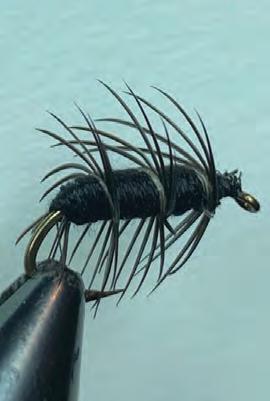
order businesses of which we were aware. Remember, this was preinternet! Thus, we had to make do.
As we enter the winter season, I’m reminded of a trip to Cataloochee in January when I was 15 or 16 years old. Possessing neither the funds nor access to cold weather fishing attire, we made do by wading the frigid waters in old pair of hunting boots and blue jeans. Being the tough, or not so wise youth that we were, we would take turns wading in the icy, kneedeep water. While one fished, the other walked and trotted back and forth on the road to get the feeling back in his legs! It timed out well as about the time the fisher lost all feeling in his legs, the walker had gotten his back!
Years later, an opportunity arose that became a funny story my wife now loves to share. When we were dating, we had driven to Big Ed’s Pizza in Oak Ridge. On the return, I was driving down a major four-lane highway when I saw a dead crow that had been hit. Making a quick stop onto the shoulder, she thought I had lost my mind; the first of many such moments to come. As I was dodging oncoming traffic like a game of Frogger, I quickly grabbed the flattened remains of the dead bird and tossed it into a garbage bag stored in the trunk for such “emergencies”.
Fast forward to last year. We were driving down a two-lane backroad to avoid interstate traffic as we headed to our hometown. There it was: a nice dead crow in the middle of our lane. I drove by it, never slowing down. Immediately, I sensed her giving gave me that “are you okay?” look. Without a word, I made a U-turn to get the prize.
Don’t get me wrong, it’s not just crows; any kind of dead bird is a possibility as well as fur bearing critters. Once, I was riding my road bicycle with some friends when I stopped for a dead yellowhammer. If you’re familiar with Smoky Mountain fly-fishing, you know the historical significance of this woodpecker. Emptying out a small
plastic bag, I took what was left of the best feathers, placed them in the bag, which I slid into a back pocket in my cycling jersey, and continued on my way.
“That is the weirdest thing I’ve ever seen,” commented one of my friends. They received a lesson in opportunity!
To this day, I’m still on the lookout for items that I use to catch trout on that rarely can be found in stores or online. One of my favorites was a Pomeranian we had named Taz. Taz would sit and watch me tie flies from the doorway into my tying room. He was trained to not approach any closer as there might be a wayward hook misplaced on the floor. One day, I saw some loose twigs of hair on the back of his ears. Hmmm… Hence, the Taz fly was invented and what a fly it was! Sadly, Taz passed in 2005 and I lost my supply and friend. If you’ve read my book, “Tails of the Smokies”, you know about the Roscoe Fly. Now you know its origin.
Still, there’s no limit to the possibilities. Just last night, I was at Home Depot when I stepped out of the car and saw an old hairbrush. I’ve been looking for a nice replacement for Chinese Boar Hair, which I use for the antennae on my fly, Jim’s Grampus. Invented in 1985, it is the most successful fly I’ve used for catching large trout in the Smokies, local tailwaters, and Montana. I picked up the old hairbrush to study the bristles while my wife gave me the “are you ok?” look. Sadly, the bristles didn’t provide what I needed.
For now, I’ll just continue “Makin’ Do”.

Iwill start off by mentioning that I use an old Hummingbird 561 unit and have since it was on my boat when I bought it. I must say that I have located and caught a lot of fish with this unit, and I am thankful to have it.
In this article, I will give a run-down of pros and cons of the live sonar units
(in my opinion). Also, the effects on the fish population in certain East Tennessee lakes plus the effects on Tournament fishing in general. Before we get started, let me say that I have fished with live sonar on two different occasions, on two different lakes here in Tennessee: one being Cherokee and the other being Douglas.
While at the present time, I do not own a live unit of any kind but was able to get out on the water with Slab Happy Pro Staffer and Crappie Guide, Tobie Cameron of (Cameron’s Guide Service) on Douglas, and Slab Happy Lures Pro Staffer and tournament angler, Chad Cates on Cherokee On two different occasions, I spent one full day on two separate lakes with each of these accomplished anglers and the results of the experience changed my views 100%.
First, let me state in the beginning that I was totally against live sonar on our lakes, period!
My first impression, like that of a lot of the old timers I know, was “Man, this is going to kill the crappie population on our lakes that are already suffering as it is”, such as in Douglas Lake. Another factor that boiled me dry (in my unjust first impression) was the thought of all the long, bitter cold days I put into learning all I could about crappie
fishing and how some mediocre fisherman can just swoop in and take my crappie! These guys haven’t paid their dues likeI have!
Again, let me state that was my unjust opinion of live sonar.
Well, let me explain my opinions on those above-mentioned statements and thoughts and correct them. I have seen first-hand that although you may find and see the fish, this does not mean live sonar can make them bite! As a matter of fact, I had the opportunity to test this while fishing both with Tobie Cameron and Chad Cates on two separate lakes (Cherokee and Douglas). It was apparent, right off the bat, that even when we saw schools of fish and cast into these schools that, once the bait got to them, 80% of the time the fish would either turn away or follow the bait up several feet while never committing to a strike. That being said, live sonar will give you an advantage over traditional sonar for locating and seeing the size and school of crappie/ fish in an area and help in determining if those fish are active or not, thus saving a tournament angler or guide a lot of precious time. Again, what live sonar will not do is make those fish bite! Furthermore, live sonar will not take away all those memories that you made with those you have loved and cared about and the experiences that you have acquired, if the unit happens to go out.
My final outlook on all of this is that technologies are evolving at such a high rate in today’s world that we must continue to take advantage of each opportunity, and each tool, to make the industry and the sport more competitive, successful, and enjoyable for all anglers!
Tight lines !
TELLICO PLAINS continued from page 2
With a distinct lower section with its many water falls, plunge pools and bedrock rapids, the more challenging middle section with its lower gradient and long riffles and glides, or the upper section with its classic Appalachian plunge pools and pocket water, there are plenty of options to suit your style and test your small stream skills. North River Road parallels the North River for most of its length, meaning that access is easy in all but the highest of mountain tributaries.
Other Small Streams – For the small stream enthusiast, the Tellico watershed has one of the finest collections of small water in the Southeast. Starting at Turkey Creek and continuing all the way up into the smallest of headwaters, just about every creek that holds water year-round is teeming with wild trout. The nearby Citico Creek watershed has hatchery supported waters as well as wild rainbows and native brookies in its own right. To many, the ultimate prize is to catch one of the Southern Appalachian’s native brook trout. These little gems are as beautiful as trout get, and the Tellico area is blessed to have over 20 miles of stream where these natural treasures have maintained a foothold despite decades of shrinking habitat. Thanks to the efforts of local and state groups including restoration projects lead by the Tellico Trout Hatchery, the South’s only native trout is sure to have a strong presence in the area’s streams for generations to come.
If you’re interested in knowing more about our small stream wild and native trout resources, be sure to ask us for more information at the shop. We would be glad to point anyone interested in the right direction. Just be aware, these streams have remained wild for a reason, make sure you’re prepared to put in the work and you’re sure to be rewarded!


When you think of winter bass fishing, slow and meticulous retrieval speeds come to mind. If you go fishing during a cold weather trend those patterns can be the case but on a warming trend power fishing can also be the option. In some scenarios, speed cranking can be the pattern to go with. The right cranks to use will have a tight wobble while the other winter lures will have a similar look and movement. You can select silent lures with ghost colors for the clear water. The more you put your time in, the more you will pick up on this.

Most people will avoid these cold months and, that alone, can make your odds go up. Lower fishing pressure and no competition is a good thing. If you’re worried about staying warm the fishing industry has already rolled out some very good warm weather gear technologies to keep you comfortable. To prepare, I like to keep my rods and reels in the warmth of my home. Most fisherman just don’t have the option of putting your boat inside a warm building but keeping your gear and your batteries warm goes a long way to help you keep your mind on what you’re doing. I have noticed that since I have been storing my boat inside my basement, I do not have to worry about my line and guides freezing up on me. All these little tricks can add up to a trouble-free fishing experience.
I will say that bass will be in one area and gone the next. I believe that, with the warmth of the sun, fish will relocate to the warmer areas from hour to hour. Look for wood and rock to pull these fish in. These features will absorb the radiation of the sun and stay warm throughout the end of the day. Some bass will go deep for the warmer water, while the surface temperatures drop. These are clues to where you start your work. I usually start fishing deep before the first light and then move to the sunny side of the lake. This plan has always helped my numbers go up.

Upsizing is usually not what people think about doing when you have cold water but when small bass stop biting, large bass still need calories and presenting a large easy meal will cause a big bass to pay attention. For these lager baits, I usually use an eight-to-ten inch wedge tail swim bait. The drawback is that you crawl these baits so slow on the bottom. You are not looking for a reaction, you are looking to fool them. These baits need a good natural look to pull that off.
Wintertime is the time to look for “silver linings” and out “of the box” thinking. I hope this helps for people looking for something different this time of year. It’s all about gaining knowledge and getting better.

Owner StriperFun Guide Service, Tennessee and Kentucky Walleye, Bass, Crappie and Muskie Charters, Superbaittanks.com, Captain Jim Marine Electronics and much more…… Greetings to my readers! I hope that the world finds you and your family doing well!
COME VISIT BEAUTIFUL THE BEAUTIFUL CUMBERLAND RIVER FOR FABULOUS WINTERTIME FISHING TRIPS – CALL EARLY WHILE WE STILL HAVE DATES AVAILABLE!
Captain Jim Fishing offers Trout charters December through April below the Lake Cumberland Wolf Creek dam in Kentucky! This type of fishing is both “drift fishing” jigging bait (for huge Rainbow and Brown Trout up to 13 pounds!) and casting small lures on ultralight rods and reels to catch “schooling” smaller (1 to 3 pounders) Rainbows. You will love this new and exciting type of fishing!

Tennessee Walleye Charters stays busy fishing for Walleye and Sauger on the Cumberland River near Gainesboro, Tennessee all winter long – December running through the end of March! The beautiful flowing waters of the Cumberland River are loaded full of big fish. The Cumberland River is a world class Sauger and Walleye destination (fishing for 2 people only on the Cumberland River)!
We also offer Walleye charters on the Holston, Powell, or Clinch Rivers in Eastern TN.

The Fishing for the Clinch River is year around and the Holston and Powell River fishing begins November 15, running through the end of March! Be sure to book your November through April Walleye and Sauger trips on the Cumberland River and Walleye trips on the Powell, Holston, or Clinch Rivers in Eastern TN! You are really going to love this exciting way to fish these beautiful rivers! The Fishing on all of these waterways begins November 15, running through the end of March!
It is great to be alive and be a “free” American! I look forward to seeing all of you this year on the water. Always remember to stop and shake the hand of a person in uniform or wearing garb that shows they are a veteran! Their service is why you speak English, can vote, and can enjoy the freedoms you do! Until next time, blue skies and tight lines!
With full USCG and State licensing and insurance, all guides who take Captain Jim’s clients (15 guides on 14 waterways) can take you on a safe, fun, and unforgettable fishing adventure! Check out all of our fishing services as well as our exclusive “online” store at www.striperfun.com or call 931-403-2501 to make reservations today.

When Margaret Robbins and Thomas Schacht wanted to purchase a forested tract southeast of Johnson City years ago, they set out to do so in order to permanently protect the land. Last month, the couple completed the donation of the tract to Southern Appalachian Highlands Conservancy (SAHC), fulfilling their goal to preserve the land.



“This place is very close to my heart, and I’m so glad to have it protected,” shares Margaret. “It became very clear to me early on that we were the temporary custodians of this place – and I’ve done everything I could do to keep the land healthy. We were so glad that we were able to connect with SAHC to make long-term conservation of the land possible. Working with SAHC’s Land Protection Director Michelle Pugliese was a joy.”
Margaret and Tom own a farm bordering the Dry Creek tract on the northwest slope of Little Mountain in Carter County, TN, less than a mile from The Laurels Picnic Area. Twenty years ago, they saw that the forested slope behind the farm was on a path to be subdivided and developed, so their family purchased it with the long term vision to conserve the property. In the ensuing years, they have cared for the land and set out on mindful projects to improve stewardship of the forest and wildlife habitat. In November, they donated the 67-acre parcel to Southern Appalachian Highlands Conservancy, with the intent that it would become part of Cherokee National Forest in the future.
“That was always our original purpose in acquiring the land, to protect it,” says Tom. “And now we’ve reached a point in life where we are downsizing and want to ensure that the land is protected going forward.”
The tract shares a boundary with Cherokee National Forest and can be seen by visitors going to The Laurels Picnic Area. An ephemeral spring leading to Dry Creek runs along one edge of the property.
“A lot of water flows down into the creek from the mountain, especially in spring,” says Margaret. “There is an understory of rhododendron and a canopy of maple, hemlock, some pine, and oak coming through. The land was logged about 60 years ago, and the forest has been regenerating since then. I was able to secure Lari beetles (Laricobius nigrinus) to help protect the hemlock trees on the mountain from the invasive hemlock woolly adelgid. We’ve seen a lot of wildlife getting pushed onto the tract as properties surrounding the area have been developed, so we set up wildlife cameras and have enjoyed watching the images of a mama bear with two cubs. We’ve also seen the usual wildlife – deer, skunks, raccoon, fox, and an occasional blue heron that comes through.”
“I was raised in New Jersey, in an area that had lots of open space and a dairy farm located behind our house,” continues Margaret. “We loved finding all the interesting and spooky things in nature. Now, there are no longer any farms there. When we heard that this tract was up for sale about 20 years ago with the potential plans for subdivision and development, we wanted to preserve it. Having seen and experienced that loss of open space in my childhood home, I have a deep appreciation for the importance of undeveloped land and wanted to make sure it is available for future generations as well. We’ve seen what that loss looks like and didn’t want it to happen here.”
Tom also has a deep appreciation for nature and environmental care, stretching back to childhood.
“I grew up on 600 acres in Connecticut organically farmed by my father –before organic farming was even a thing,” shares Tom. “He had seven children and taught all of us to respect the land and respect nature. One of his favorite sayings was ‘I see God in every blade of grass.’ That’s one of the
values I grew up with, and Margaret shares that value as well.”
“It is a property I have used as an escape,” adds Margaret. “I am so glad that it all came together and we were able to donate the land for it to remain protected.”
As Tom and Margaret began the process for permanent conservation of the land, they contacted Cherokee National Forest and Southern Appalachian Highlands Conservancy about the tract becoming part of the national forest. Because land transactions with our agency partners can take time, sometimes years to complete, Southern Appalachian Highlands Conservancy has a long-established reputation of working with landowners and forest service partners to assist in the addition of public lands. As a non-profit organization, we are often able to move more quickly to complete initial transactions – which can be an important factor for landowners. SAHC plans to own and manage the property as a nature preserve, until it can be transferred to become part of Cherokee National Forest.
“With gently sloping topography at elevations ranging from 1,900 feet to 2,100 feet, these 67 acres could have been lost to development if it were not for the generosity and dedication of Margaret Robbins and Tom Schacht,” says Land Protection Director Michelle Pugliese. “We are grateful to Margaret and Tom for having the vision to preserve this property, and to our partners in the forest service for working with SAHC in order to add to public lands. We deeply appreciate the generous contributions made by SAHC supporters to cover transaction costs so that this project could be accomplished.”
This is a story still in development, as we continue to research the history of the land. Be sure to check back for updates and look for the Dry Creek article in our upcoming View from the Highlands newsletter!
The time was late October, we rose before the dawn, Six men in concert, yet each was still alone. No one led and no one followed, yet each one did his part, Like a dance or a piece of music that someone plays by heart.
We met at the appointed place and loaded all our gear. We left our comfortable beds behind and all those we hold dear. We were off on an adventure, a week in the woods or more, None of us really knew for sure what this week held in store.
Three of us were walking down from Clingman’s lofty Dome, Three of us would pick us up and return us back to home. It was an honor to be among them, good men everyone, All of them are brothers and one also my son.
We passed by the Oconaluftee, a little past Cherokee, Where, out of the mist walked a majestic elk, like a ship out on the sea. I’ll never forget that image burned forever in my mind, Life went into slow motion; I lost all sense of time.
The views at the top were wonderful, majestic, and serene. The valleys still wore their cotton linens, the air so fresh and clean. Mountain ash adorned with rubies, emeralds in the pine, The woods breathed out a rich perfume, healing for both the heart and mind.
The packs were heavy, the air was chill. The way was long but all downhill.
Double Springs Gap, we take a water break, Talk to some hikers while we hesitate.
We made Hazel Creek Cascade that first night on the trail, Felt good to rest our backs and sit down on our tail. Steak and baked potatoes, our celebratory meal, I’ve had bigger but never better, it was quite a deal.
The brookies were small but beautiful and responded to my fly, We left them there in their quiet pools nestled against the sky. A silent testimony to all that’s pure and clean, A fish in whom there is no guile, with beauty like a queen.

The next day took us to Proctor Creek, then on to Calhoun, The weather couldn’t have been better, we even had a full moon. The fishing was good, we all caught our share, God was good to all of us but particularly good to me there.
These are God’s finest sculptures, anyone can see. And here we walk among them, wonderstruck and free. It was a veritable garden kept by God’s own hand, Even the logging scars inflicted on her by man.
I’m inspired by her beauty, humbled by her power, Indebted by such a gift, it becomes a worship hour. An out of doors cathedral illuminated by the sun, An altar made of granite, open to everyone.
Bone Valley then to Sugar Fork, we’d all been here before, But it all looked and felt different, coming in the back door. We pitched our tent and stretched our tarp the first time on our way, It’s good we did for it was raining before the break of day.
The fish didn’t care they were already wet, so we caught a few. David missed a big one using alternative methods too. Halfway up the gorge there’s a waterfall that plunges to a beautiful pool, That’s where Moby Dick lives; you can’t catch him, that’s the rule.
We walk on down to Proctor trudging in the rain, Our mood a little somber, a little akin to pain. Half want to stay on a while and fish a little more, Half want to get back home to those whom we adore.
Jim, Jerry, and Jason are there to meet us and light a waiting fire, A welcome sight if ever I saw one, a dry place in the mire. We sit and talk and remember way up in the night, We speak of beauty seen and obstacles, every fish and fight.
you come far Pilgrim... It feels like far.
Ben Bailey, is a native of Western North Carolina, Master Carpenter, Avid Angler, and Naturalist.


 By David A. Ramsey
By David A. Ramsey
What’s simple ain’t always easy. It’s a truth that applies to so many things in life, including the act of doing the right thing. Ethics, in angling or almost anything we do, is that personal moral compass that points us in that “right thing” direction.
Too often, though, we ignore the reading and veer off course. Regularly failing to do the right thing defines a person even more than doing it. It’s one of the first things we consider about someone when getting to know them.
But it’s not that in a given situation, we consciously think to ourselves, “I want to do the wrong thing here.” It’s that we are highly skilled rationalizers. In a split second, we acknowledge the right thing and the wrong thing, tell ourselves we really are good people, then justify our wrong actions with being short on time, or not wanting a little extra hassle, or because it somehow has something to do with those evil (pick your political party) trying to take away our freedoms.
I once heard someone say their personal motto was, “Do the right thing, right now.” Tough to stick to sometimes, but a great motto, nonetheless. It’s a concept we could stand to follow a whole lot more in our sport. Teddy Roosevelt, our greatest outdoor-loving, conservationpreaching president, said, “To educate a person in mind and not in morals is to educate a menace to society.”


There are several angling ethics lists out there, some of which are solid, some too long and redundant. I think it really boils down to just a few basic things we can do to make our sport, our natural/recreational resources and ourselves, as anglers, a lot better.



I know a lot of sportsmen who have lived honorably by these principles for most of their lives. Conversely, I know too many other ol’ boys who still live to run wide-open, “rip lips” and run up numbers—fish, environment and other fishermen and recreationists be damned. The longer I live, the more I want to be remembered in the company of the first group—and for never missing a chance to call out the second.
David Arthur Ramsey is an outdoor photographer, writer and conservationist, born and raised in the mountains of northeastern Tennessee. His outdoor writing and photography have been published locally, regionally and nationally and are most often associated with work to preserve and protect threatened lands and waters throughout the Southern Appalachian Mountains.


into the good life slip into the good life
1. Respec t other anglers and recreational users
Follow the laws and rules of the water
Respec t and protect all natural resources at all times
Keep only fish that will definitely be eaten
Make every effort to quickly release fish unharmed by hook or hand
Give aid and assistance to those in need
Give back to the sport via the three S’s: Sharing, Service and Stewardship


We at Big Ol’ Fish Guiding Service want to start off by wishing everyone a Happy New Year! Hopefully everybody had a great Christmas and got lots of new fishing gear, lol. Now that January is here, it’s time to put all that stuff to good use. So, with that being said, January is a perfect time to get out there and catch some nice trophy stripers. Fortunately for you, we can help you score those monster Western North Carolina stripers. Lake Hiwassee is a hidden gem and perfect for catching some awesome stripers, and, as Murphy, NC’s #1 fulltime guide striper service, we are here to help put you on some hardfighting fish. Guaranteed! Check us out on Facebook and you’ll see! Currently, water temperatures on Lake Hiwassee are in the upper to mid 50’s and water levels are around 36 feet below full pool. Water clarity is moderately clear.

Striper fishing really has been excellent recently! We’ve been catching a lot of nice fish in the 15 to 30-pound range, and a lot of them too. These fish for the most part are shallow and pounding baits on flats in the backs of creeks. Pulling planer boards and free lines early in the morning has been working great. Huge gizzard shad and blueback herring is always the bait of choice this time of year. It’s so stinking awesome to see a huge 30 pounder explode on a bait at the end of a planer board. It will definitely have you hooked on striper fishing once you experience this thrill. Back on track now…occasionally, we’ll also pull small trout as well. Also, look for these fish in deeper water schooled up, especially on warm days. Our trophy striper season has been in full swing and these techniques will
continue for the next few months.
January is a great month for catching a lot of monster stripers on this Western NC lake. Give Big Ol’ Fish Guiding Service a call and let the area’s #1-rated guide service put you on some of Lake Hiwassee’s best trophy stripers during the fishing trip of a lifetime. We are Murphy, NC’s and Blairsville Georgia’s premier full-time guide service, specializing in striped and hybrid bass. We also serve Lakes Nottely (Blairsville GA), Chatuge, and Lake Blue Ridge in Blue Ridge, GA. So, come fish with the pros for the opportunity to be featured in Angler Magazine, and let us help you get your fish on!
Shane Goebel owns Big Ol’ Fish Guiding Service and is a member of The Angler Magazine Fishing Team. See the website at www.bigolfish.com or call (828) 361-2021


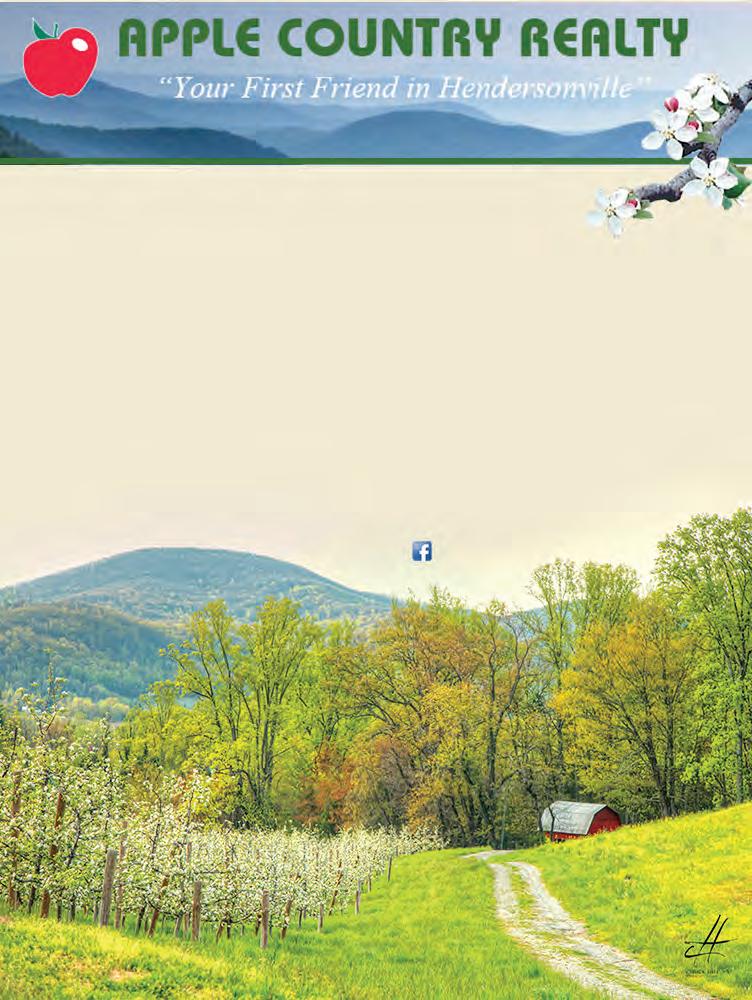
Hey folks! I sure hope the holidays have been special for you. The older I get, the more I love them because it gives us an excuse to get together with family and enjoy catching up. The rest of the year, it seems like we are so busy with work and everyday life that we just don’t take the time to sit and talk with our loved ones. I’m probably more guilty than most as with the guiding, I’m so busy during most of the year I just don’t ever seem to find the time I need. I guess I’m lucky to have a job where I get to spend time seeing folks having so much fun. It’s hard not to feel like you’re a part of their family.
One of my Funniest trips this year was with my grandson, Coy. We had such a great morning watching the bears on the shoreline and catching big spotted and smallmouth bass. I hope he’s like me and will remember these times for years. I can remember when I was a boy, too young to fish myself, following dad up the creek feeling so important holding the forked stick that held the fish dad had caught. It was years before we got a creel to hold the trout we caught. I still remember the first creel I ever saw Freelon Woodard was fishing Alarka Creek and he was wearing a wickertype fishing creel. Fishing gear has come a long way since then, with the advancement of rods and reels and fish finders, it’s mind boggling. Fontana
one thing’s for sure…everyone’s going to be smiling.
As for a January fishing report, it’s been really good. The spotted bass have been the dominant species hitting on Fontana. Due to the exploding bait, they have been a little tougher to catch but we are seeing some real pigs. Santeetlah an Nantahala have fished as good as I’ve ever seen, with the catch being mixed with smallmouth, largemouth, and spotted bass, along with some huge yellow perch and a few nice crappie. Techniques are really varied; I’m a live bait guy so I’m throwing minnows but have had good luck on Rapalas and soft plastics. The top water bite has been a little off, seems more of my catch has been 20 to 50 ft deep.

As much as I love saying take a kid fishing. This may not be the best time for that as the cold sometimes is a little more than they can stand. If you do take them out, just dress really warm and take lots of snacks. I guess we’re lucky with the heated jackets and the hot pocket hand warmers. Just make sure to make it an enjoyable trip and you will have a fishing buddy for life. Happiest of holidays to all and I hope 2023 is great to you all!

Even with this being the start of a new year, January always seems more like the end of things rather than the beginning. With our typical January weather being less than ideal, it begs more for reflection than anticipation in my way of thinking. Working as a contractor for forty years has made me appreciate rainy and freezing weather where folks’ expectations were slightly lower. No one is going to insist that you continue a framing job or finish grading a lot with six or eight inches of snow on the ground. In the same vein, most folks aren’t going to insist on six or eight hours of piscatorial ravaging if water is hard frozen all around the ramps. Time spent indoors now can be used as review time, as to how the past year has gone without losing actual time doing what we love best.
There are those rare times though, where the sun shines and the temps rise and if you are able, a trip to Fontana can be one of the best of the year. I have found that the really big smallmouth seem to love the winter. If the water is liquid, I’ve even caught nice ones when it was snowing. That can warm you up in a hurry. Fish are typically shallow and will hit a jerkbait if fished slow with long pauses. My deadliest bait though, is a squirrel tail jig tied on a black and chartreuse jig head. Fishing with folks, not guiding where I had to share, has brought monetary offers for one of my jigs. Seems like I would only have one or two which made the price way out of reach for most of my friends. Don’t know why that jig works, it doesn’t look like anything that I know of shimmying along the drops, but those
brown babies sure love it.
The other good thing about winter fishing is that when you find some, there are typically lots more in the vicinity. We have had years where a big school of fish would hang for weeks at a time off a point but since the



Iwas recently going through the fly-tying section of an outdoors store, when something interesting caught my eye. In the middle of packets of dubbing and other various tying materials was something I would expect to see more at the crappie fishing section of bass pro shops:
“Hareline Squiggle Worms - Brown/ Olive” - Essentially, small soft plastic worms.
This sparked in my mind the musings of an age-old debate that has been around since the development of beadhead nymphs as to the arbitrary line that separates fly fishing from conventional fishing. Within recent years, that line has become ever more blurred and harder to recognize. Squirmy worms are essentially trout magnets with extra steps. Fly tying companies are starting to sell overpriced ball head jigs for “streamers”, and common fly fishing accessories can now include ball bearing swivels, fly clips, and even crankbait lips for fly tying.
Seriously, are we really even fly fishing anymore?
Now granted, I’m definitely not a fly fishing purist. I look at all types of fishing equipment as tools for different jobs. This is where the lines to me start becoming very skewed, because we are starting to misuse those tools for purposes they were not designed for. For example: I could theoretically throw a senko from an 8-weight fly rod. I could also
theoretically cast a dry fly with a spinning rod and a casting bubble. Neither of those scenarios, however, would be very productive, and would also be a handicap in learning how to fish with each in a more proper manner.
Distinguishing the difference between fly fishing and conventional fishing is not to say that one is objectively better than the other. I do think that the line between them is important for anglers to establish from a sense of inherent moral respect for the skill and knowledge it takes to learn when to use the right tool for the job. In my opinion, it becomes a disservice to the legacy of anglers before us who’s ingenious inventions have developed the lures, flies, and techniques that we are blessed with the knowledge of today.
With that said, I think it’s worth answering this question for ourselves as individual anglers in regards to our own fishing. It’s not that there’s anything inherently wrong with taking components from conventional fishing and applying them to fly fishing, and vice versa. But how can we then progress in our own skill sets when we don’t even know how to use the basic tools properly in the first place?
I wonder now in which direction fishing, as a whole, will evolve/ devolve towards, because it seems we are at a crossroads within the
angling community, where the primal instinct of catching as many fish as possible is taking over the more refined and transcendent view of fishing as a means of philosophical ascendance into an action that is greater than merely catching fish. Overcoming the challenges of learning new techniques is by far more rewarding and meaningful than to corrupt what fly fishing or conventional fishing was meant to be in the first place.


Granted, this is all just my opinion, but I found it to be an interesting thought.
continued from page 19
senseless reintroduction of those cute little otters, this is rarity. They can scatter a school of fish faster than a deep dynamite blast.
Pray for the occasional warm day or two, get out when you can, and prepare for a quick turn in the weather. If you are out, use your head; falling out into 40-degree water is way different than falling into 90-degree water-life jackets are just that. If it’s too bad just remember what that spring day was like with fish every 3 or 4 feet down the bank. Remembering is a start towards anticipation of what’s to come. Thank you, Lord, for memories of fish past and those yet uncaught. Holler if you want to try it on a nice day, Later, Capt James.
Capt. James McManus owns 153 Charters. Give him a call for a great day on the water at (828) 421-8125.

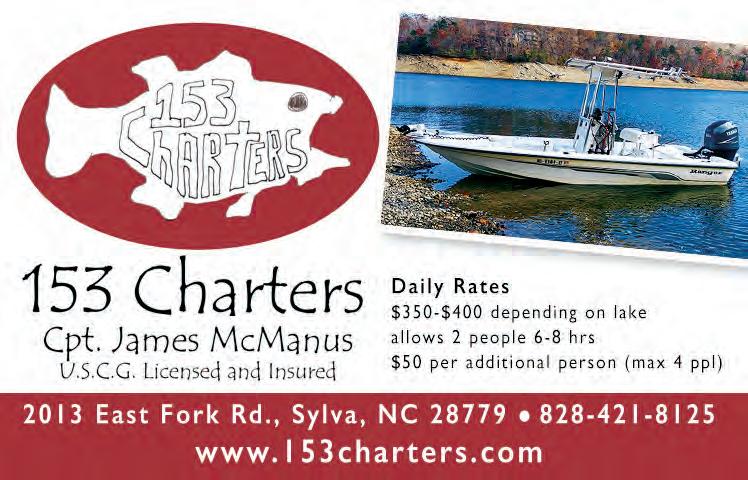

The happy holiday season has now past, and the long winter nights have settled in for January. Great rains of December have filled the rivers and streams around us here at Chattooga River Fly Shop. River flows have been great, and the fishing has been even better. Many large fish were being caught throughout December, and the trend looks to continue thru January.

Now the winter fishing season is upon us, and it is time to layer up and catch big winter fish. At times, with the heavy rains, the rivers will take a few days to subside from extremely high levels and unsafe wading conditions. After this, the rivers will fish extremely well, with many large fish being caught. Do not let the cold weather keep you home, just dress appropriately and enjoy the rivers. We have found using the wicking base layers and the Redington I/O Fleece Pants to be very beneficial, for keeping warm while wading. Let’s not forget about top layers either. Wearing a wicking base layer shirt, and then a fleece and an insulated coat, depending on the daytime temperatures.
Many large fish are being caught using tandem nymph rigs, with larger nymphs as a lead fly and a smaller nymph as the trailer, tied off the back end of the lead fly hook. Casting these tandems slightly upstream, and dead drifting these flies through the seams is essential. The seams are those areas where the water is moving more quickly than the area of the slower moving water. There are many flies to choose from, as the lead flies and as the trailers; we have a tremendous supply in stock, and please check out our “hot list”.
As for the streamers, big fish are being caught on these as well. Casting out and across fast moving water, dead-drifting, and then a strip-andpause back to you along the seam lines has proved to be extremely effective. Keeping the streamers low in the water column is also a key to success, as
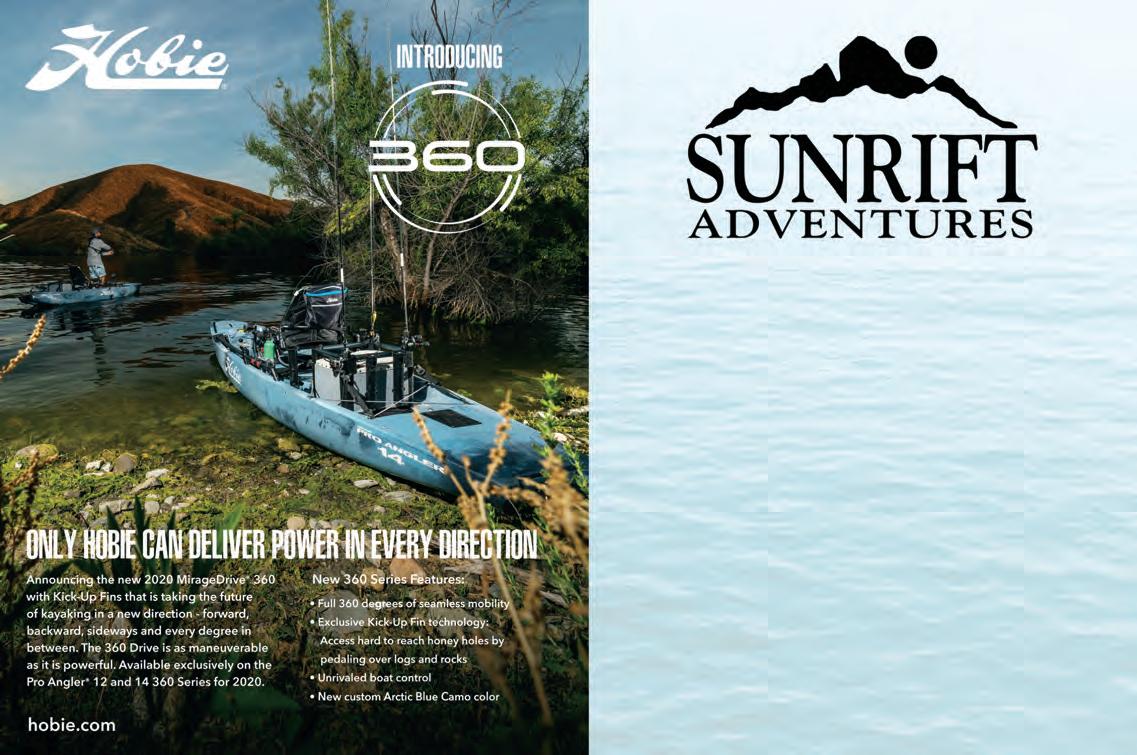

Now that the holidays are over, it’s time to start thinking about your on-the-water transportation for 2023. Regardless of whether you are considering buying a new boat, a used boat, or just sprucing up your existing boat, you have lots of options. With all the choices available, choosing the boat that’s right for you can be overwhelming and time-consuming. One of the best places to explore all your options is at an NMMA Boat Show, like the Discover Boating Atlanta Boat Show this month.
A boat show offers the opportunity to get up-close-and-personal with a variety of makes and models. Looking for a new bass boat? How about a wakeboard boat? A personal watercraft or a pontoon? They’re all there, and you can compare features, options, and pricing… all under one roof.

Perhaps you want to spruce up your current boat with new decking, or maybe you need to re-power with a new fuel-efficient Honda outboard. It’s all there. Plus, you will find a huge assortment of accessories for your boat and your dock; from water toys to dock furniture.


What’s special about the early season boats shows, like the Atlanta Boat Show in January, is dealers are ready to ‘deal’. Many will have last year’s models that need to be moved to make room for this year’s
models. And many will have extra incentives like upgrades and great finance rates.
Now that I’ve got your wheels turning, here’s a couple things to consider while you are on your quest to achieve New Boat Nirvana.
First…your boat buying journey should be a fun one. But you’ll need to do a little homework before you start shopping.
1. Do your best to select the boat that’s right for you. Seriously consider how you’ll be using the boat. Fishing…or cruising? Or both? How many people will you typically have on the boat? Look at the capacity plate that tells you how many people it can carry and the maximum horsepower it can handle. Do you intend to pull skiers or water toys? If so, be sure you have enough horsepower to do the job. Unfortunately, I see a lot of new boat owners who are aggravated because they purchased an under-powered boat. You may want to increase the horsepower to the maximum shown on the boat’s capacity plate.
2.How well does this boat hold up over time? Every boat looks great on the showroom floor. But not all boats are built alike. While doing your homework, try to narrow it down to a couple brands and styles. Then try to locate that same model used boat for sale, one that’s around four or five years old. See how well it’s held up over the years. Look at the wiring in the console, the hatch hinges, the gel coat, and upholstery. Essentially, what you’re looking for is just how well the boat has held up over the years. Does it look like a great boat that’s four or five years old, or does it look 20 years old? Quality does come at a price, especially these days. So don’t let a great price tag be your only deciding factor.
3. If this will be your first boat, or if you are moving up to a larger boat, then I highly recommend taking a Safe Boater Course offered by the US Power Squadron. You’ll get great information to help you be a better, safer boater. From how to safely operate your boat, to Rules of the Road, to dealing with emergencies on the water. And, by successfully completing the course, you could realize discounts on your boat insurance too.
So, kick off the New Year at the best place to explore all your boating options…the Discover Boating Atlanta Boat Show at the Georgia World Congress Center, January 12 - 15, 2023. And while you’re there, come by the Fishing Center and see the new Wide Open II, my tricked-out, ShearWater 270 powered by twin Honda 250’s. Buck, The Wonder Dog and I will be doing fishing seminars every day to help you put more fish in the boat. So, stop by and say hi.
Shopping for a boat can be overwhelming, but it doesn’t have to be. Have fun, do your homework, and attend a boat show to find your new dream boat. There are a wealth of boat buying tips to get you started on the right path. Check out our downloadable Boat Buyer’s Guide at NutsAndBoltsFishing.com or visit DiscoverBoating.com.
Tight lines and calm seas.

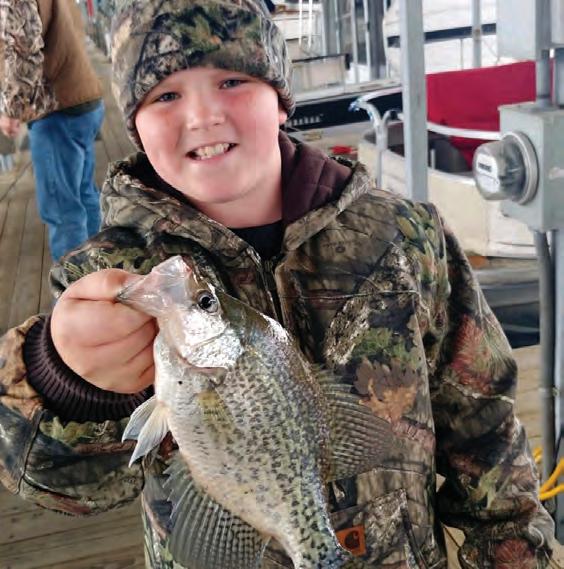 By Gary Carney
By Gary Carney

January is my favorite time of the year to get out and catch some fish for the freezer. The water on most Tennessee lakes is cold and most fisherman are at home enjoying the warmth and other activities. Along with the lack of fishing pressure on most local bodies of water, comes the opportunity to stock up on a supply of your favorite fish. I usually target Crappie during January and my favorite choice of spots are marinas if you can gain access to one.
The cold water is the start to the pre spawn Crappie season which usually starts around March, depending on the climate during any given year. Which means around almost any structure you can find that’s in or adjacent to deeper water, the Crappie will start gorging themselves with bait to prepare for the spawn. Also, this structure absorbs the heat from the sunlight and slightly warms the water around the structure. Best bait is live minnows with your rod rigged with #2 light wire gold hook, small float, and enough split shot sinkers to just barely keep the float above water. This keeps the wind from pushing your float around and gives the fish biting it a sense of little resistance when taking the bait. Just remember to start out with your float shallow and then go deeper a little at a time until you find the depth they are holding. As a general rule of thumb, crappie will come up in the water column for bait but won’t go down to get it.
Small tube jigs and hair jigs can also produce nice numbers of fish. If possible, have a variety of colors to offer, because when fishing with jigs the fish can be picky on color from one day to the next. When fishing with jigs this time of the year, make sure you slow your presentation because of the cooler water temps. The good thing about catching prespawn crappie is that the majority of the fish will be larger in size and can be caught bank fishing around piers, boat docks, boat ramps, and other structures, making it fun for all fishermen including those without a boat. So, grab your rod, some jigs or minnows, bundle up and get out there for a quiet and peaceful day of fishing.
“Keep Those Poles Bent and Those Reels Cranking!”



The Pattern is pretty much the same for December as it was for November. Fish as close to the bottom as possible for the bigger fish as the water temp gets lower. Plenty of bait showing up in big schools. Shad mainly, but we are starting to see the big schools of menhaden. Look for gulls and pelicans diving on the menhaden. Drop live baits or throw swim baits into the bait schools. You can find plenty of stripers in 30-45 ft this time of year. Creek channels are a great place to start. Look for bait and fish, then set your baits right above your marks. Live herring and shad will
work the best. Not as good as the warmer months but you can still catch the more active fish on spoons. Jigging vertical is the best presentation. There is some schooling activity being reported on the lakes in the early morning and later in the evening. Cast plastic swim baits into the schools. Look for the BIRDS.
The big bream and crappie are on the deeper brush in 28-35 ft in huge numbers. The colder the water gets should result in the fishing and fishsize better and better. Crickets are the best bait for bream and jigs and minnows will be the bet baits for the crappie.
With the weather and water starting to slowly cool down, lots of crappie will be headed to deeper brush preparing for fall. Look for crappie on brush in 12-25 ft. on Lake Marion and 28-35 ft on Moultrie. Casting small jigs and tight lining minnows will work the best. Long lining in the deeper creeks is starting to produce some crappie.
Lots of schooling activity on the Cooper River in the mouths of the old Richfield cuts. Top water and swim baits will work well.
Plenty of catfish in 40 to 55 feet of water, as well as shallower flats and creeks in 20-25 ft. Drift cut shad and herring with Santee Cooper rigs in the deep channels. Lots of blues of all sizes (especially the good eating size at 3-5 lbs) mixed in with channel cats are being caught.
Saltwater Bushy Park. Lots of speckled trout and slot sized reds are being caught mainly on live mullet/mud minnows and shrimp under a slip or popping cork. Fish the edges of the creeks. Falling tide seems to be the best tide to fish. Lots of flounder are also being caught but most are under sized, so make sure you know your regulations.
Hills Landing & RV Park is located in the quaint town of Cross, SC.


Our property sits directly atop the banks of the Diversion Canal, perfectly nestled between Lake Marion and Lake Moultrie. We offer an RV park in addition to standard accommodations for rent, a newly graded and paved boat landing and docks, and a spacious new laundry facility and bath house. For added convenience, there is a general store on site which sells gas, ice, live bait, tackle, food items, charcoal, rv accessories, and an array of other necessities. Free WiFi is also provided, with the option to upgrade for faster speed.
After 20 years of traveling around the globe, Tony and Stephanie Goodwin felt a strong
desire to come back home to South Carolina and grow some roots here once again. Originally from Columbia, South Carolina, they have lived in South Florida for the last two decades, working in the yachting industry, until March of 2020. They knew they wanted to be close to family and friends, but also wanted to be on the water and put to use their experience in the boating and hospitality industry. Next thing you know, the Goodwins were signing their name on the dotted line and became the new owners of Hills Landing.
“The Goodwins want people to know that all walks of life are welcome here! They are all about good times, smiles, and laughter! They invite you to come and have some fun together.
First off, let’s recap: 2021 was rough for my Bucket List, but I checked off the Sailfish! I ended up catching seven before the year was out. Thank you, Capt. Jimmy Dean! In 2022 I got on a fishing roll. With Capt. Johnny Stabile’s help, I checked off the Big Tarpon in Biscayne Bay under the skyscrapers of Miami lights. We also went to the Everglades to check off Oscars, Bullseye Snakeheads, and several other species that weren’t even on the list. Here’s to hoping 2023 continues to be great for my fishing life! Now to the list, and there is no rhyme or reason for the order, by the way.

1. The Swordfish. Still at the top of my list. I am going to try hard to get this one checked off this year. I have a couple of possibilities I’m working on.
Catching the next couple of fish on my Fish Bucket List will depend on whether I make it back to Alaska to fish in the summer or not. I did make it back in 2022 and took five friends with me. We fished until we couldn’t fish anymore, but still didn’t get these checked off. My hit list for Alaska still includes:

2. The Salmon Shark. The smaller cousin of the great white, it is an apex predator of Alaska, like the grizzly. I plan to go out of Resurrection Bay in Seward in hunt of the salmon shark. As of right now, I don’t have a captain selected for this, so if you have a recommendation, kindly email me the info. At up to 1000 pounds and 10 feet in length, this fish will be a worthy opponent. They average more in the 200-300 pound and 6-to-8-foot range.
3. The Halibut. A 300 pound or bigger halibut to be exact. This will also most likely be out of Seward, Alaska since I have several friends who fish out of there for halibut. It may take several years to find this fish, but every halibut is an adventure. I love fishing for them there and out of Homer.
Back to the Lower 48 list:
4. The Snakehead, northern species. Why? Only because I have never caught one and like a good Pokémon Go player, I need to catch them all! Or at least one of every species that is big enough. I think Pennsylvania is where I plan to look for these fish.
5 The Sturgeon. This one is new to the list (as I check some off, I add some new ones ��) This fish will require some travel, but it will be worth it. After watching Ty Kleeb’s (TyPigPatrol) video, I decided that this one looked like a fish I wanted to catch. My friend Brent Riddle caught one a few years ago, and he said it was awesome too.
6 The Giant Alligator Gar. This is a trip I have talked about for years and just haven’t been able to pull off. Dawson Hefner and I have talked about fishing for the giant alligator gar, so I just have to get out there to the Trinity River and make this happen. Dawson regularly guides people to catch monster gar. Maybe this will be the year!
7. If I get back to Brazil, the Redtail Catfish is on the list! We tried to get one when I was there last September but had no luck.
8. The Bluefin Tuna. This one may be on the list for a few years, but it is getting more and more thought. My friend Mitchell Vandiver has been telling me about catching tuna at the Prince Edward Island area, PEI as they all call it. The more we talk about it, the more I think that one is going to move up the list. My other choice of locale may be North Carolina if I don’t make it to PEI this year.
9. The Goliath Grouper. I would like to manage to just reel him up and take some awesome pictures and release him back to his deep retreat. Again, this is a Florida trip for me. I have several friends that want to do this too, so it should be a great trip when we pull it off.
10. A Musky, I have never even seen a live musky! I saw the lures they have in Bass Pro in Illinois, and I was like “What are those giant lures for? Musky, wow they must be BIG!”
11. Jaguar Cichlid. They are just a cool looking fish and so they made the list. I actually have a separate cichlid list and invasive species list I’m working on too.
12. Last, but not least, Bluegill– not just any Bluegill, one over 3 pounds. I hope to travel to Lake Havasu, Arizona with friends this summer to check this off the list.
That’s my list and there are a ton of other fish to catch out there. If you
have time, email me and tell me about your list for 2023.
I want to also thank some people who make my fishing better! Troy Soukup at the Happy Hooker; Damon Melco at Xtreme Bait Tanks, David Ashby at Bottom Dwellers Tackle, the people at Columbia Sportswear, and my captain and fishing friends Dewayne Proffit, Santee, SC; Joe Dipietro, McCaysville, GA; Jimmy Dean, Daytona Beach, FL; Eric Crowley, Ellijay, GA; Chad Smith, Eatonton, GA; and Capt. Johnny Stabile, Pompano, FL. Make 2023 your best fishing year yet! Please remember, if you are not going to eat it, don’t kill it.
“Tight Lines and Squealin’ Reels put a smile on my face every time.”
Please check out Gary’s YouTube channel: Fishing With Gary. If you want more information about fishing, you can reach me at gary@purgeright.com.
FISH continued from page 22
with the colder water temperatures, the fish are holding low in the river. The use of a weighted leader or pinching on a piece of weight a foot above the streamer, will help.
On warmer days, some dry fly fishing may be at hand. Don’t be surprised to see rises as the winter days warm from the early day cold to the 50’s, maybe 60, and fish start rising. Pre-hatch fishing nymphs and emergers on the swing, will be the ticket, and then switching to dries will be the key to success.
If fishing in the cold weather outside is not your cup of tea, join us for a fly tying lesson inside our warm shop. We offer one-on-one fly tying lessons for the beginner, or to those that want to learn new ideas at the vise, just call for an appointment. We hope to see everyone out on the rivers and please don’t forget to “Leave No Trace”!
Karl and Karen Ekberg are co-owners of Chattooga River Fly Shop, located at 6832-A Highlands Hwy, Mountain Rest, SC 29664. Give them a call at (864) 638-2806 and visit their website at www.chattoogariverflyshop.com.

Flies for effective cold weather fly fishing here in the mountains can differ in size and pattern significantly. Systematic approaches to various stream conditions can also help break the catching code. Frigid cold mornings aren’t usually a good time to be throwing dry flies, that’s for sure. Before my first cast on a winter’s day, I make sure I have my leader and fly selection tuned in for pinpoint presentations. Fishing the shortest leader possible will increase the odds of getting the fly close enough to a trout’s nose that he’ll take a swipe. It has to be long enough to reach the bottom of the pool easily and rapidly for a dredging presentation because that’s normally where the trout will be with 33-degree water. Czech nymphing is great for this. Icy water will normally have the fish’s strike zone about the size of a ping pong ball, in other words, that fly literally needs to almost bang that fish on the nose. A lot of times I’m just trying to get a reaction strike, not a feeding reaction. Fly size can range from size 6 bounced streamers to size 20 midges. I will usually start with large flies such as a Wooly Bugger or Pat’s Rubber Legs, then hopefully I’ll find the fish in the mood to eat a big bite and then work down from there. It’s a whole lot easier to land a big trout on a large sized hook than a teeny one. If that doesn’t work smaller nymphs or egg patterns or even a San Juan Worm or a squirmy might be the ticket. If I have to go even smaller, Zebra Midges or Rainbow Warriors get the nod. Swung flies such as soft hackles and small streamers or intruders can also be extremely effective in enticing a stubborn fish. A slow “static swing” as I call it, can be just too much for a trout to handle. Making the fly easy to catch and easy to eat is a good way to look at winter
fishing. The river sweeping of a Spey type presentation can cover every inch of water and get that fly in the magic zone effectively.
Water conditions such as super clear clean water call for more natural looking fly patterns. When we have high or stained water, it’s time to break out the bling. Brightly colored flies, or the color white or even black, can be more easily seen by a trout. Weighted flies are easier to get down quickly and stay there. You should be getting hung up every now and then to be sure you’re deep enough. If you are snagged every cast, lighten up a bit.
The daily rise in the water temperature can fluctuate three to four degrees if the sun is shining brightly, even on a cold day. The highest winter water temperatures on a nice day will usually peak out around two pm. That will probably enlarge the trout’s strike zone too from a ping pong ball to maybe a softball, making it much easier to hit the strike zone. Be sure to be there at the time of peak activity, it may only last a couple of hours before the fish lock down. See you on the river!
Give David Hulsey a call at (770) 639-4001 to book a class or a guided trout trip. See his website at www.hulseyflyfishing.com
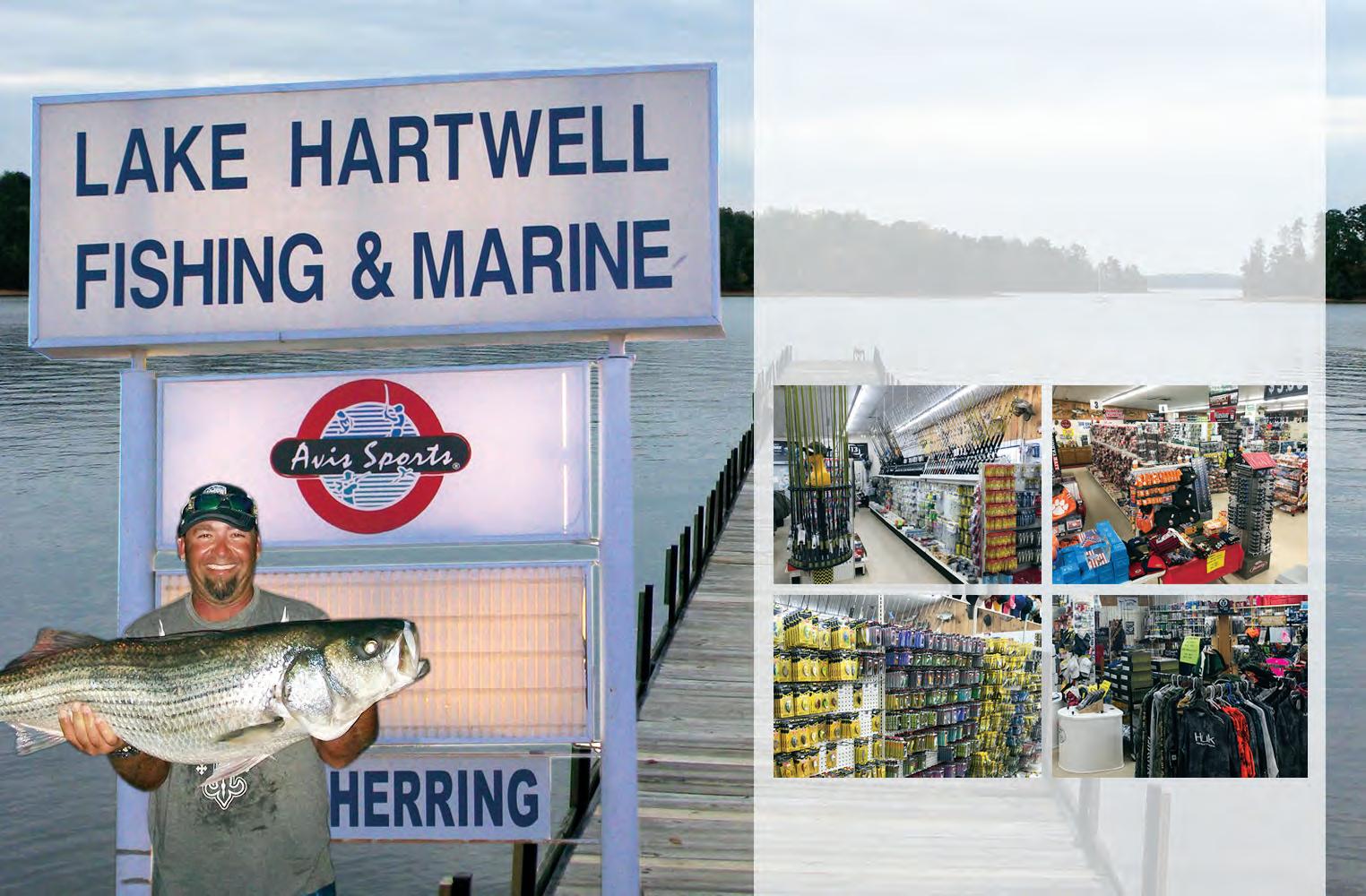



Berkeley County is a wonderland for outdoor enthusiasts, sports bu s, adventure seekers, and water lovers. From exemplary fishing for striped bass, or a trophy largemouth bass, to our hiking trails and water activities, along with scenic outdoors where you can catch a glimpse of white tail deer and gators, Berkeley County has activities to fit all visitors and families.

Learn more about Berkeley County at: exploreberkeleycounty.com



Researchers have designed and tested a new style of hook that takes catch-and-release to a whole new level. ese “bite-shortened” hooks are intended to allow sh to “release themselves” without being handled by the angler.

Dr. Holden Harris, a postdoctoral researcher at the University of Florida’s Nature Coast Biological Station, was the mastermind behind the study. In his write up on Hook Line & Science, a North Carolina Sea Grant blog, he promoted the bene ts of e cient de-hooking and minimal handling of caught sh to considerably improve chances of survival for released sh. e hook he tested is a modi ed jig, which researchers clipped at the point, so that this “bite” portion of the hook—the business end— was reduced in length from 15 mm to 10 mm. e simple modi cation just clipped the barb and vertical length beyond the bend of the hook before it was re-sharpened. Harris tested it against a standard jighead as well as a jighead with the barb led down on 150 spotted seatrout. ey went shing with all three jigheads, reeled in the sh and then allowed the sh to op around boat-side until they either did or did not come unhooked.
“We found promising results for the bite-
 HARRIS
HARRIS

shortened modi ed hook, which enabled anglers to land 91 percent of hooked spotted seatrout and then release 87 percent of those sh without direct handling,” Harris wrote. “In comparison, the self-release success rates were 47 percent using barbless hooks and 20 percent using standard, unmodi ed hooks.”
Additionally, Harris found that smaller seatrout were able to “self-release” at higher rates than larger ones.
Coastal Angler contributor and seatrout-on-














arti cials guru Michael Okruhlik has written on his use of barbless hooks when targeting pods of trout crashing bait. He said the ability to quickly and safely release sh without taking them out of the water allows him to get back in the action faster.
Maybe anglers would use a hook designed to let sh come unbuttoned?



For a video of this hook modi cation, see https://youtu.be/VC23oNikyc8


Every year in Basel, Switzerland, the world’s best-known luxury watchmakers gather to display their new timepieces. It’s a great event for spotting timepieces that standout–– in performance and in personality. We saw one impossible to ignore: a precision dive watch with an arresting green dial. But we also saw the five-figure price tag and knew we could bring our customers that exact same precision and stand out appeal for a whole lot less. The Stauer Evergreen Diver is that timepiece.
Built like a submersible battleship with a stainless steel case, caseback, and band, the Evergreen Diver is water-resistant down to 660 feet or 20 atmospheres, a feat facilitated by a hardened crystal and screw-down crown.
Green On Your Wrist AND In Your Pocket. You could pay an awful lot elsewhere for this verdant virtuoso, but the majority of the cost is in the big designer name upcharge. We think those guys are all wet. This is how you own a top-of-the-line dive watch without helping pay for some marketing guy’s yacht.


Satisfaction Guaranteed or Your Money Back. Wear the Evergreen Diver for 30 days. If you’re not completely happy, send it back for







Amonster gold sh aptly named “Carrot” has been making the rounds on social media recently a er the sh was caught from a trophy carp lake in Champagne, France. UK angler Andy Hackett caught the nearly 70-pound bright orange sh from Bluewater Lakes, a heavily managed, privately owned pay-to-play shery that boasts of carp weighing heavier than 90 pounds.

Carrot seems to be somewhat of pet, but not the type you’d keep in a sh bowl. She is a crossbreed between leather carp and koi, and was stocked in the lake 15 years ago to give anglers an interesting sh to pursue.
“I always knew e Carrot was in there but never thought I would catch it,” said Hackett. It took him 25 minutes to reel in pot-bellied carp, which o cially weighed an astounding 67.4 pounds.
Carp caught at Bluewater Lakes are handled very carefully with a strict catch-and-release policy.

For more record sh, visit coastalanglermag.com.


Some cold but very fun shing days are ahead, and a Trapstyle bait is my absolute favorite way to sh this time of year. Typically sh group up in winter, and whether that be bait sh or bass, there are opportunities that make lipless crankbaits absolutely deadly!
rowing a lipless crank around areas where sh are chasing bait or where they are grouped up has caught lots of bass and some big ones. Even casting this bait as a search bait can work wonders. ere are so many options for lipless cranks that it can get confusing. I’ve experimented plenty, so I hope this article helps.
Traps range from ¼ oz. up to 1 oz. in weight, and every size can be used di erently. I pick sizes depending on the depth I’m shing or the depth of the structure, and I also consider the natural bait that is prevalent in the area. If you’re shing shallow or around tiny bait sh, a ¼-oz. size will be the best bet. A ½-oz. is usually my goto. It’s great for the mid-range depths of 5 to 10 feet, and it imitates a range of bait sh sizes.
A ¾-oz. is a bit bigger, and I don’t throw it as much, but it certainly has its place in 10 to 20-foot depths.


Remember, you can always vary your retrieve to get these baits higher or lower in the water column.
Color is another key factor. Ninety percent of the time, I sh a bait sh color. Whether it’s a shad, shiner or bluegill pattern, natural colors always work for me. I also throw orange or red a lot in winter. ese colors imitate craw sh, and they work where craw sh are prevalent. Match your bait color to the forage in the lake.
e last factor for lipless baits is sound related. ey come in silent, multi-rattle or single-knocker versions. I go silent for very clear water and heavily pressured sh, when appearing natural is important. e multi-rattle baits make a lot of noise, and the commotion draws strikes. My go-to, though, is the one-knocker style. is sound is unique and a little deeper pitched. I feel like sh, over the years, have become accustomed to the loud versions. I nd the single-knocker gets a few more bites in most situations.
With treble hooks, rod selection is important. You just reel into the sh when you get a bite, and this means your rod needs a solid backbone to drive those hooks and also a good amount of tip for keeping sh on during the ght. My go-to rod is a 13 Fishing Omen Black 7’4 Medium Heavy Moderate. e 13 Fishing Concept A 7:5:1 is a perfect reel for this application. I sh 15- to 20-lb. Seaguar Invizx line, depending on the structure I’m shing.
I hope these Trap tips help you put a few more sh in your boat this winter!






Tyler Woolcott is a professional tournament angler and guide. Check out his website at www.tylerwoolcott shing.com.




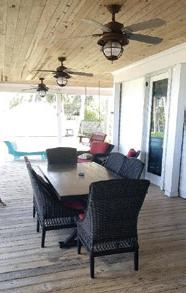
ANew Jersey angler eked out a new state record for albacore (long n) tuna in October when he boated a 78-pound, 2.4-ounce long n that bested the previous 1984 record by 3.4 ounces.

Matthew Florio, of Brick, N.J., is a commercial scalloper and he was shing with the rest of his scalloping crew aboard the Luna Sea at the east elbow of Hudson Canyon, the largest known underwater canyon o the east coast of the U.S. ey were at least 75 miles o shore and chunking for yellow n tuna, which is a technique that involves cutting up a bunch of butter sh and throwing them overboard before following up with hooked chunks of butter sh. e crew was already having a good day with yellow ns when Matthew hooked into his big albacore. He battled it in with a Kevin Bogan 30 Stand Up rod and a Penn 30 reel loaded with 60-pound mono lament. e sh measured 48 and 3/8 inches long and had a girth of 37 inches. e previous record was a 77-pound, 15-ounce long n caught in 1984 by Dr. S. Scannapiego in Spencer Canyon.
For more record sh, see coastalanglermag.com.


Now that Jack Frost has bay temperatures thoroughly chilled, only diehard lure chuckers will be found stalking the ats. Most of us have one thing in mind this time of year, catching a trophy trout. Here is how I approach my quest for that dirty 30-incher.
When water temperature stabilizes in the COLD range, all the migratory forage ees for warmer pastures. e bays are le with larger mullet as the primary food source for prized speckled trout. is is the time of year that I pull out my larger lures. is could be a longer length, a wider pro le, or both. is doesn’t have to be a 12-inch lure that is no fun to cast all day, but I do upsize from my typical 3- and 4-inch lures that I use most of the year. We have all seen a 25-inch trout with a 15-inch mullet in its belly, so they will eat something huge, but giant baits aren’t as fun to sh.

My con dence lures this time of the year are typically a 4-inch wide-pro le slow-sinking lure or a 5-inch bulky body paddletail. Since plastisol is buoyant, the bulky lure will have a slower sink rate, which I prefer under most conditions. e
slower sink allows for dual bene ts this time of year. Logically, the slower sink rate matches the slower mood of a cold sh. Also, I spend a lot of time targeting sh over shallow grass in knee-deep water. A slower sink rate keeps my lure in the strike zone longer before it disappears into the grass.
weedless hook. Depending on the conditions, I might go weightless or with a 1/16- or 1/8-ounce jighead. e weedless version keeps me out of the grass, it lessens the opportunity for my cold, less-dexterous hands to be impaled by a hook, and most of all, it does less damage to the trophy sh that I am targeting.
Areas I target will be near deeper water, have so er bottom, have visible forage, structure and hopefully be lowertra c areas. While planning trips, I take into consideration moon phase, current conditions and recent conditions when determining where to sh.
I have never caught a trophy trout by accident. I don’t know if that is lucky or unlucky, but every trout I have landed over 27 inches was on a day when I set out speci cally targeting larger sh. Case in point, if you want to catch trophy trout consistently, you must make the e ort to target them, sh where they live and be attentive to details. I know numerous anglers have caught large trout with no e ort, but most don’t catch two.


I t my 5-inch rattling paddletail with a

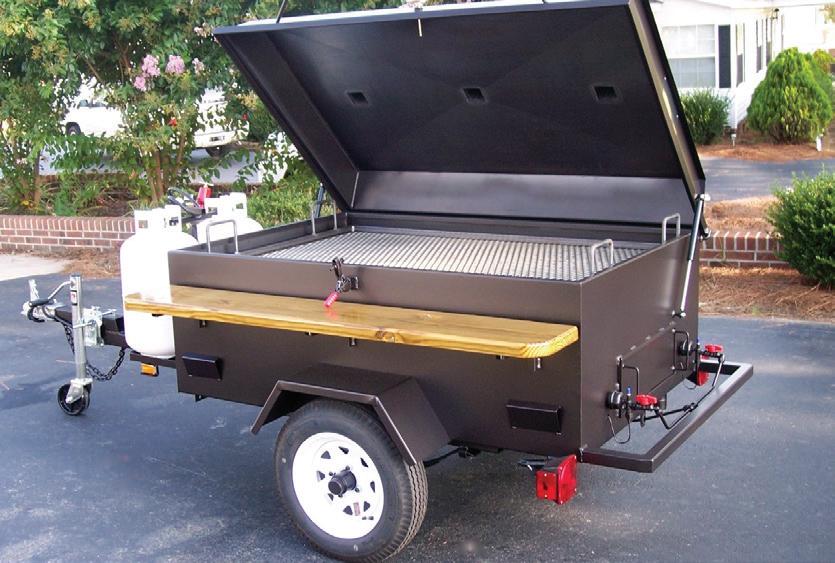
Capt. Michael Okruhlik is the inventor of Knockin Tail Lures®, and the owner of www.MyCoastOutdoors.com.

















Every season is the best season to explore the many treasures in the Upcountry.


